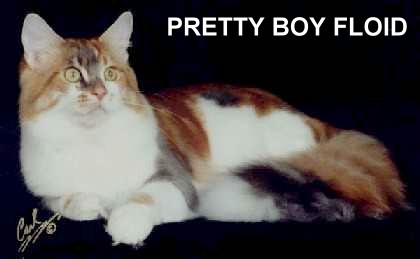 WHAT IS A CHIMERA?
WHAT IS A CHIMERA?CAT CHIMERAS (MALE AND FEMALE)
By the end of the 20th century, karyotype (chromosome) and genetic testing had become common methods to determine if a cat with ambiguous genitalia or fertility issues had a chromosomal abnormality. Because sex-linked orange and the X-inactivation process were well-known, tortoiseshell male cats were suspected to have chromosomal abnormalities, particularly in the sex chromosomes. Karyotype testing of male tortoiseshell cats found that most common causes of tortoiseshell tomcats was mosaicism, or chimerism, being XX/XY in all or some tissues. The second most common cause was somatic mutation (mutation in tissue cells). Only a few tortie tomcats were XXY (Klinefelter) individuals, and these generally had unusual conformation as well as tortoiseshell or calico patterns. Until comparatively recently it was believed that chimeras were usually only produced in the laboratory and were extremely rare in nature, but it appears that chimerism is relatively common in animals that bear multiple offspring.
 WHAT IS A CHIMERA?
WHAT IS A CHIMERA?
A chimera is the result of 2 fertilised eggs fusing to become a single kitten. If the two fertilized eggs are both XY, this gives an XY/XY male chimera. In an XY/XY chimera if one X has the O gene and the other does not then some fur will be ginger and some black because different parts of the skin originate from different eggs! It could also be a mix of any other colours found in male cats e.g. a mosaic of blue (grey) and black. An XY/XY chimera would be fully fertile.
Female cats can also be chimeras, but they are generally only noticed if they have a "genetically impossible" mix of colours in the coat e.g. a mix of black and blue (grey) patches. Female chimeras can be XX/XX (two fused female embryos) or XX/XY (where the XX embryo cells form the gonads, producing a cat that appears physically female).
In mammals, chimeras are usually only identified when there is a mismatch between the chromosomal sex (XX or XY) and the genitalia. This can come about through investigation of an illness or through visual clues such as tortoiseshell coats in male cats.
If an XY egg fuses with an XX egg (a male embryo fuses with a female embryo), it gives a XX/XY chimera containing some tissues/organs which are genetically female and other tissues which are genetically male. In an XX/XY chimera, X chromosome inactivation will occur. The three X chromosomes in the animal may contain an assortment of different colour genes (especially if the mother mated several times and the eggs were fertilized by different fathers). The physical appearance and the sexual behaviour of an XX/XY chimera depends on which structures contain which chromosomes. A good example of this is the now famous Maine Coon Solkatz Pretty Boy Floid who is a mix of red, blue and white - a colour combination impossible in a normal XY male. Poldhu the fertile blue-cream-and-white male Cornish Rex from the 1950s may also have been an XY/XY chimera; the main difference between Poldhu and Floid being that Poldhu had cream (dilute) instead of red (non-dilute).
A BLACK-GREY-AND-WHITE TORTIE TOMCAT
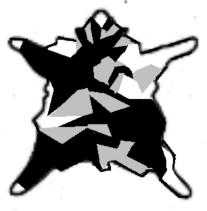 |
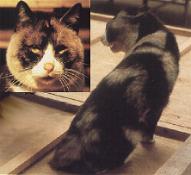 |
Somatic mosaicism and chimerism aren't restricted to red or red-and-white cats; it's just that we are more geared up to looking for elusive fertile tortoiseshell males and tend to overlook the fact that some apparently normal tortoiseshell females may be due to genetic abnormalities. Mosaics which differ from the usual patterns are also noticeable. In Japan in the 1980s, there was an instance of a beautiful blue-black-white fertile male (Panda) documented by zoologist Jeremy Angel. Like Pretty Boy Floid, Panda (born 1978) was probably an XY/XY chimera (2 fused male embryos) as he had a mixture of dilute (grey) and non-dilute (black) in his coat. His father was a solid blue cat (Mo) and his mother was Aya (tabby-and-white). The colony into which he was born was inbred with more then 70% of the cats carrying Mo's genes. In addition to his odd colouration, Panda was born with a deformed tongue and could not suckle, so was hand-reared.
Some parts of Panda's body also appear to display a higher degree of white than others. The effects of the white spotting gene are discussed in Bicolour Cats. This cat had normal male behaviour and was "very fertile". He would have bred as either a black or a blue (grey) cat depending on which embryo's cells hade formed his testicular tissue. The pelt diagram, based on a number of photographs (therefore not 100% accurate), gives some idea of his mosaicism. In many cats, these forms of mosaicism will never be noticed because they naturally have black somewhere in their coloration; when the black is quite unexpected and defies logic then mosaicism is assumed.
Chimerism might be noticed when a pair of cats produce a kitten whose colour or pattern should not have come from that pairing. For example a pair of Devon Rexes that produced a solid white (dominant white) kitten although neither parent was solid white. One grandfather was a solid white cat. The mother had some white freckles and genetic testing found that she was a chimera. Her ovaries had developed from a solid white female embryo that her merged with the female in question. The only outward sign of the white cell line was the white freckles.
LABORATORY CHIMERAS
Until recently it was believed that chimeras were normally only produced in the laboratory and usually involved chimeras made from different, but closely related, species. The geep is an interspecies chimera mixing a sheep and a goat. Unlike a sheep/goat hybrid, the sheep/goat chimera did not look like something halfway between the two species. The sheep and goat tissues retained their individual appearance, creating an animal with hairy goat-like legs and a woolly sheep-like body. Rat/mouse chimeras have also been made. Increasing use of genetic tests on anomalous animals (e.g. those with genetically impossible colours, ambiguous gender) is revealing a surprising number of natural chimeras in the cat population and may account for more tortoiseshell males than previously thought. For example, chimerism is found in cattle. When a cow has twins, they almost always share a circulatory system. Blood stem cells from one embryo end up in the other embryo and both twins end up as chimeras (microchimeras).
CHIMERIC SEMI-IDENTICAL TWINS
Chimeric semi-identical twins (reported in Nature in March 2007) are identical on their mother's side, but non-identical on their father's side. This happens when 2 sperm fertilise a single egg, which then divides to form two embryos. Each sperm contributes genes to each offspring. If one sperm is X and the other is Y, the 2 offspring may be chimeras with a mix of XX and XY cells. It is generally believed that double-fertilised eggs rarely survive, but it is also possible that chimeras resulting from double-fertilisation go unnoticed unless they have ambiguous genitalia or exhibit mosaicism. Normally, twins are classified as fraternal (2 separate eggs fertilised by 2 sperm) or identical (mono-zygotic - single fertilised egg develops into 2 identical offspring; essentially natural cloning).
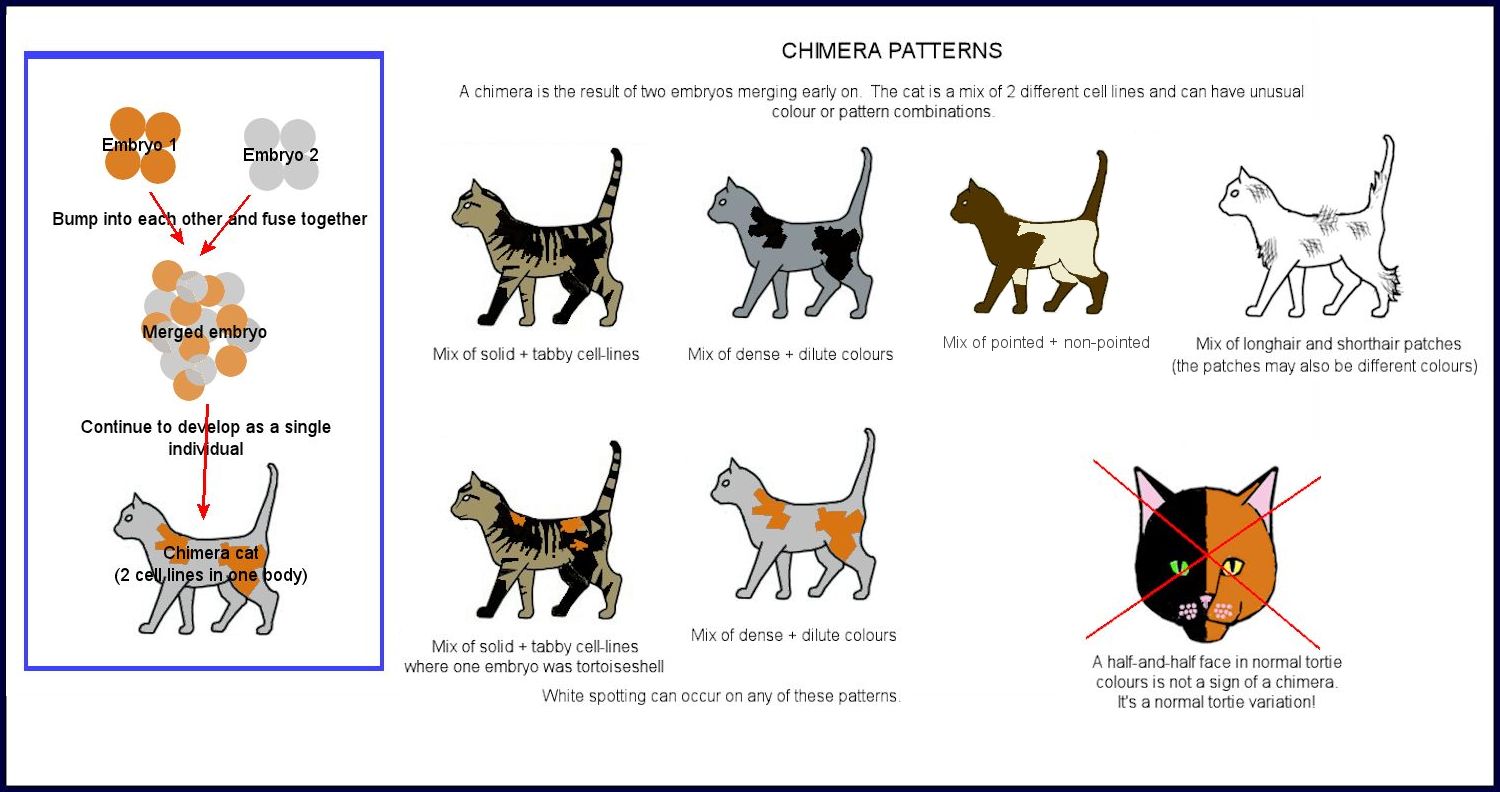
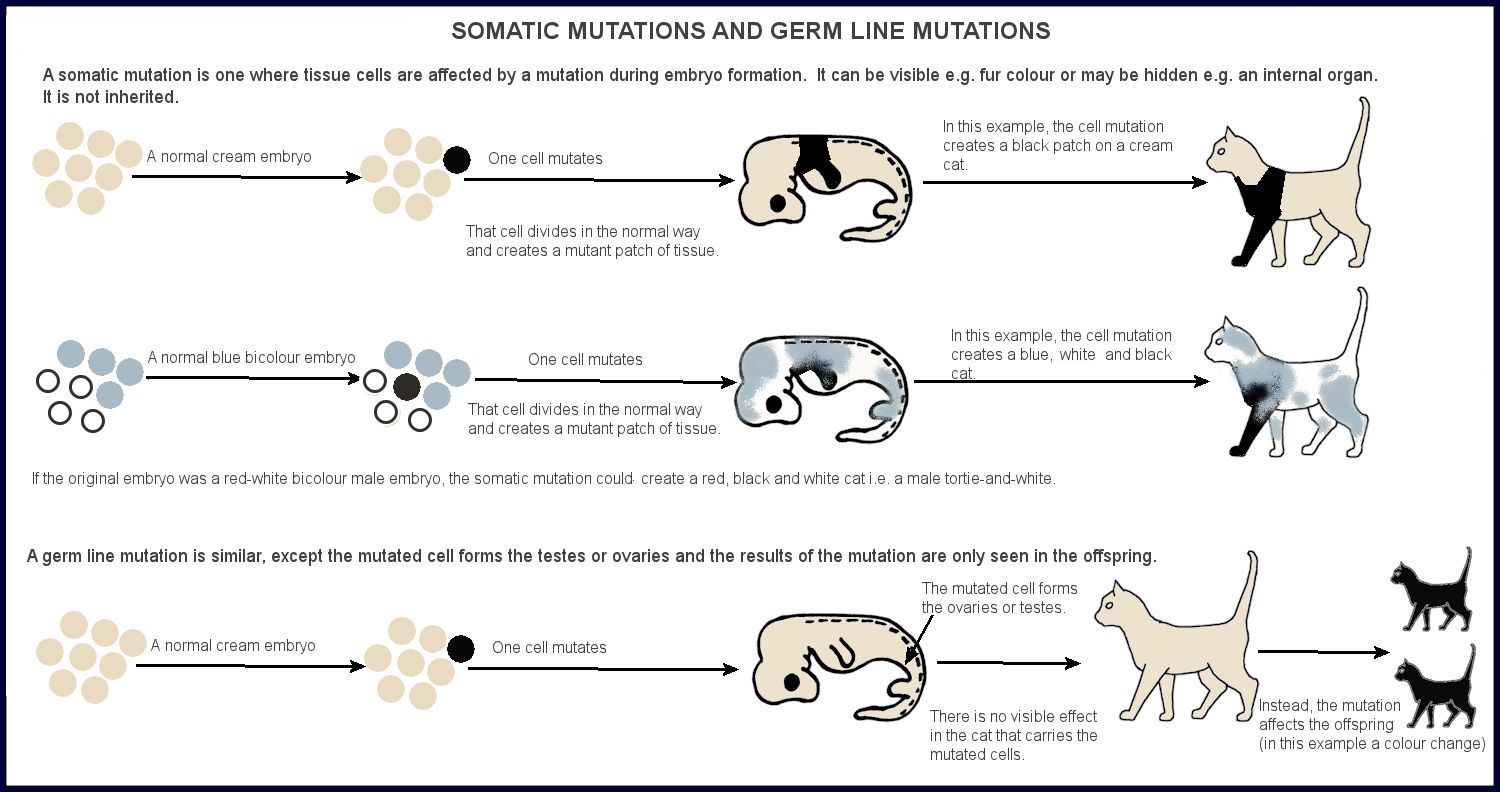
A CLOWDER OF CHIMERAS
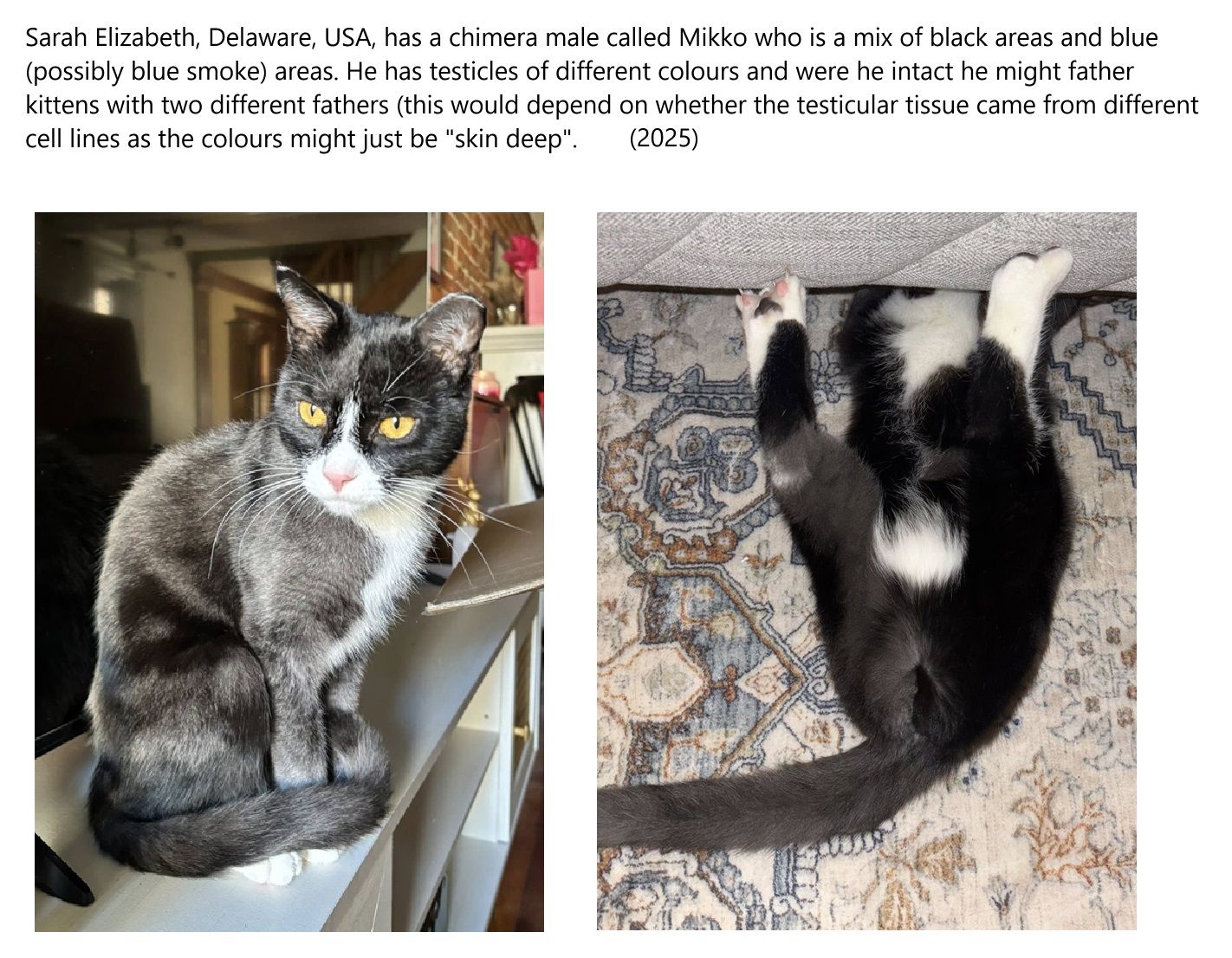
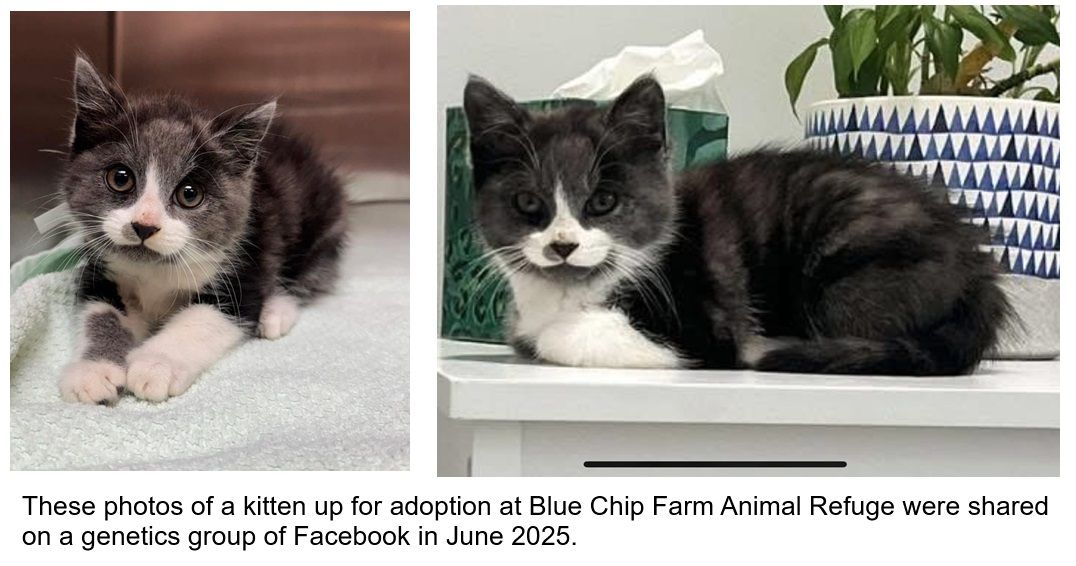
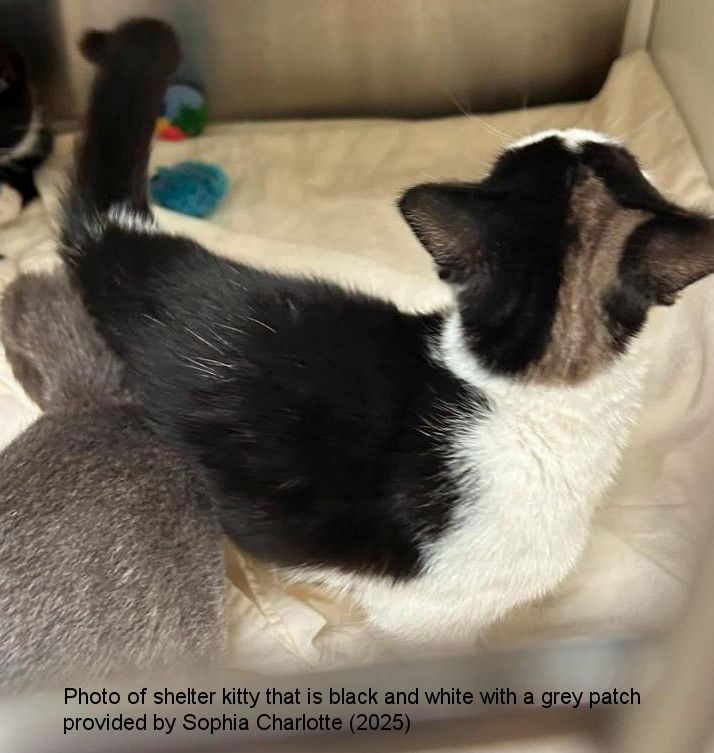
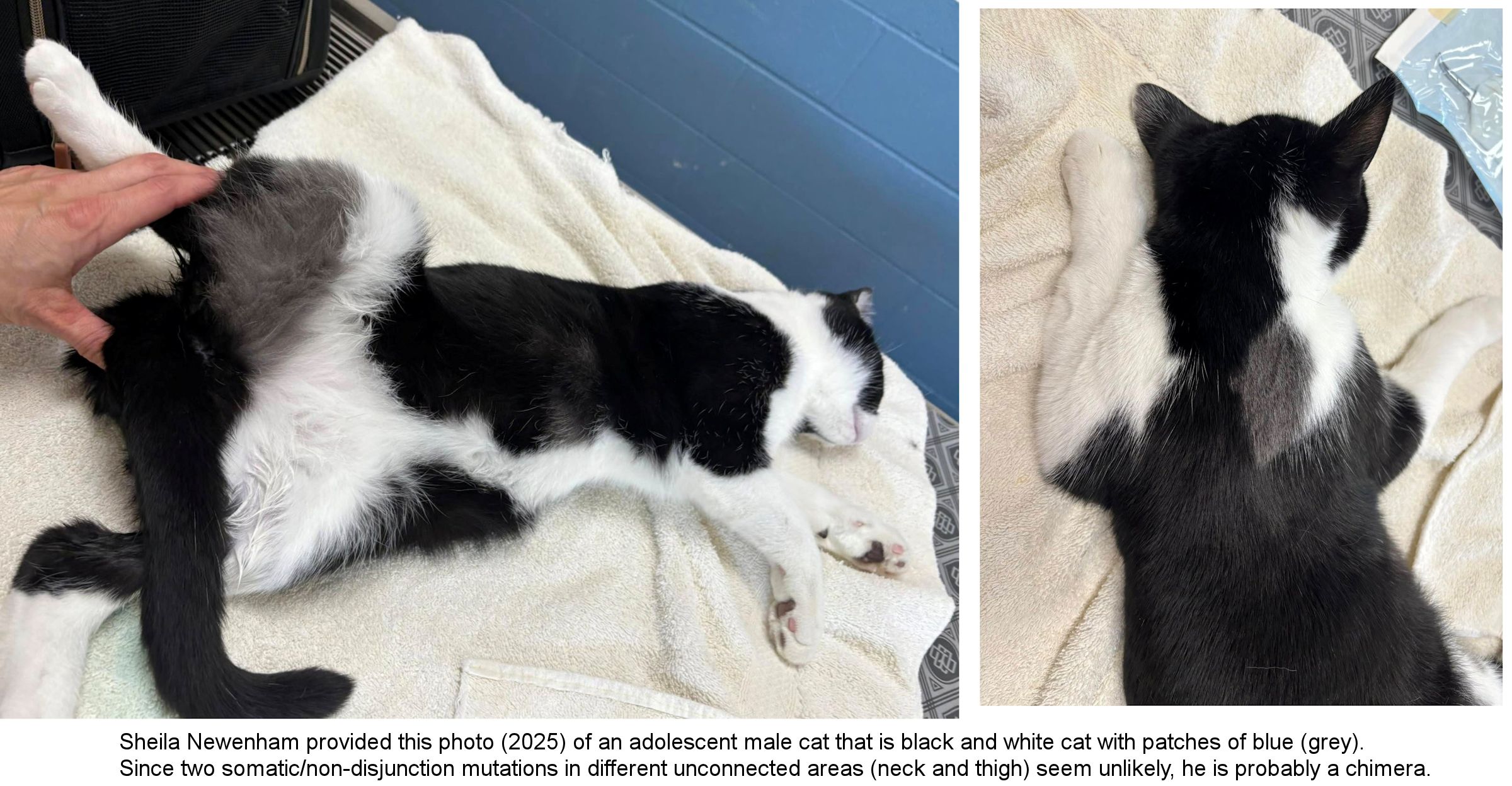
To properly identify a cat as a chimera, genetic tests are needed, so any cat with an impossible mix of colours (once everything else has been ruled out) can only be considered a "possible chimera".
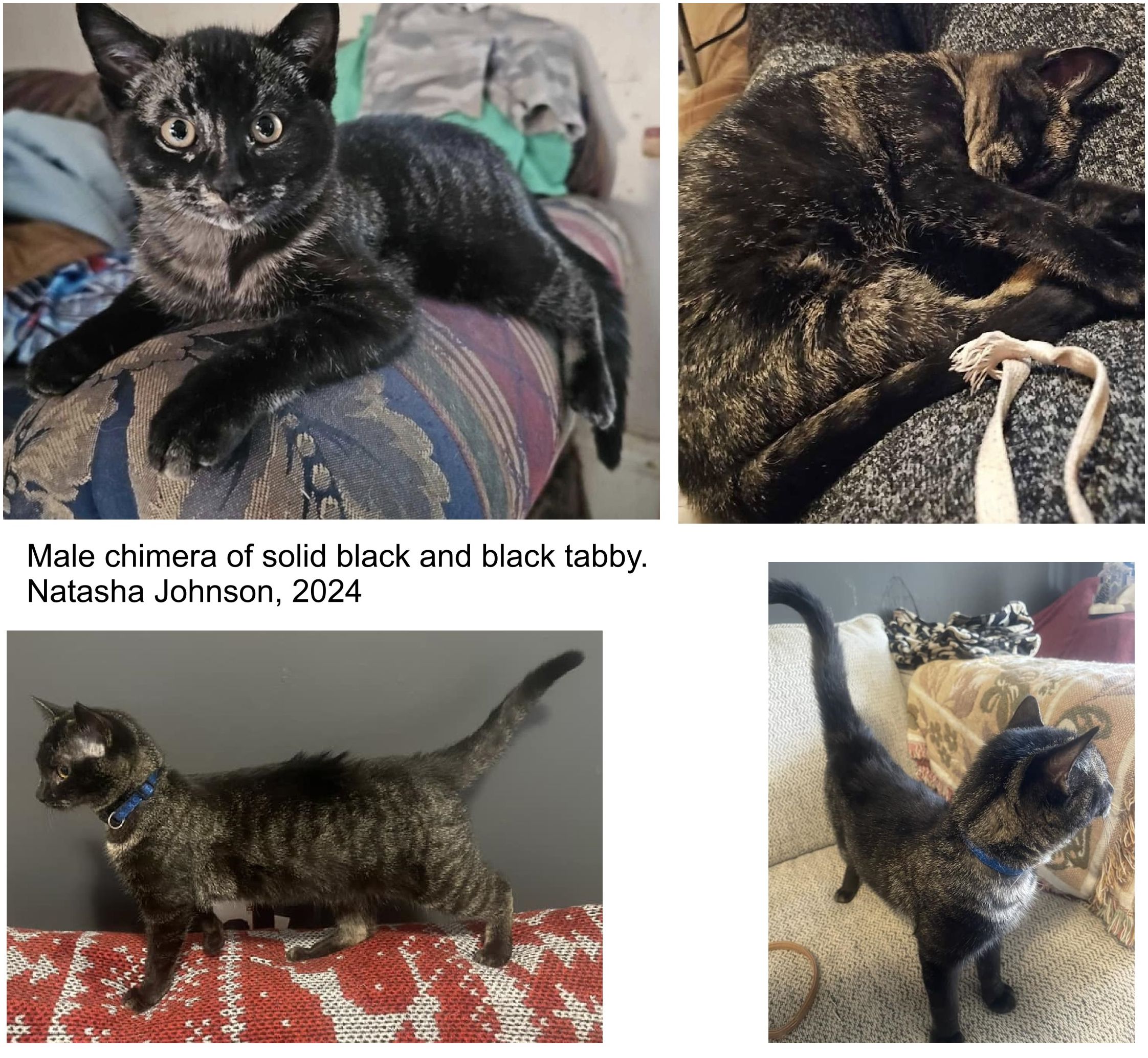
This tortie male (below) is owned by Renato A. San Mateo, and appears to have a case of chimerism where one of the embryos had pseudomelanism (abundism) which causes markings to be thicker and heavier than normal, obscuring more of the background colour. Pseudomelanism resembles the charcoal mutation in Bengal cats, but is a domestic cat mutation and occurs in cats with no Bengal or Asian leopard Cat ancestry.
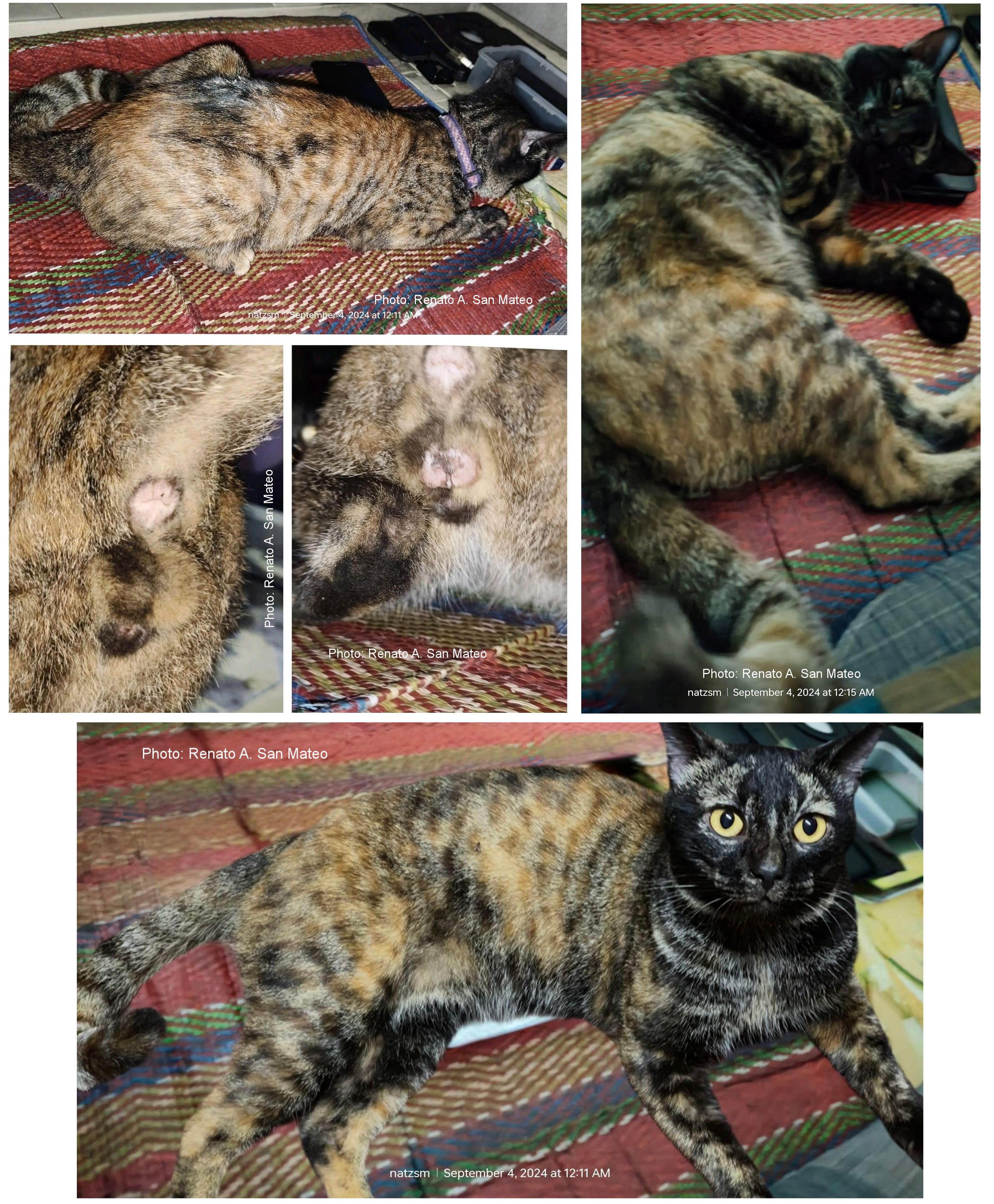
Below is Rio, a pedigree Exotic male. He was neutered with two normal appearing testicles, and the vets did an ultrasound- just in case, finding only normal male anatomy. He is red, white and blue chimera, a mix of dilute and dense colours. He is normal sized and has grown and developed normally. The baby pictures are all from his breeder Janae Grove of CidersHaven. The studio photos are reproduced here by kind permission of Richard Katris Chanan Photography. Information and photos have been provided by Meghan J. Evans of PureX Devon Rex in February 2024.
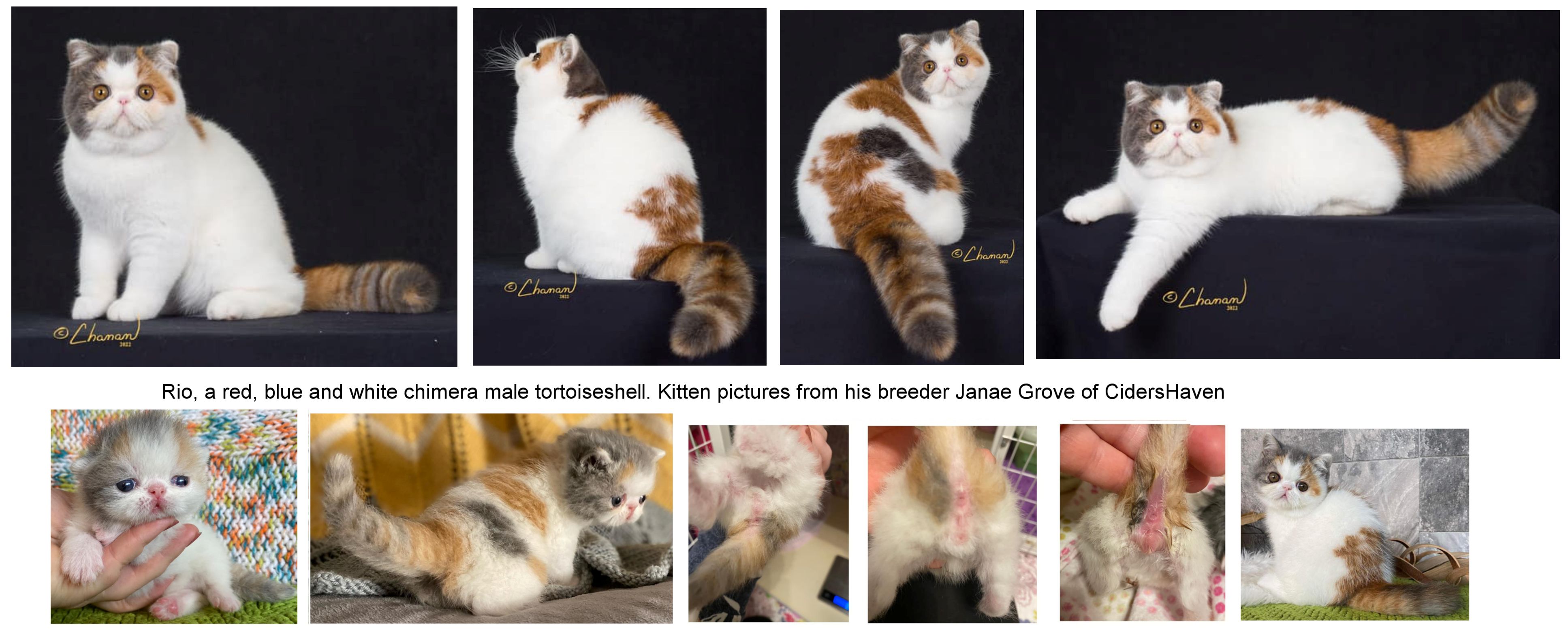
2023. Anne Williams' cat Basil is shown here aged 6 years. He was found in a bush with the rest of his litter who were all solid black with some white chests. He has mottled grey/black all over with a patch of brown on his chest, from his nose down to the bottom of his neck is split in half black and grey. One of his feet has the two inner toes black and outer toes grey, and the foot in front of that mirrors it. He looks like he's black solid on one side and black smoke/blue smoke on the other.
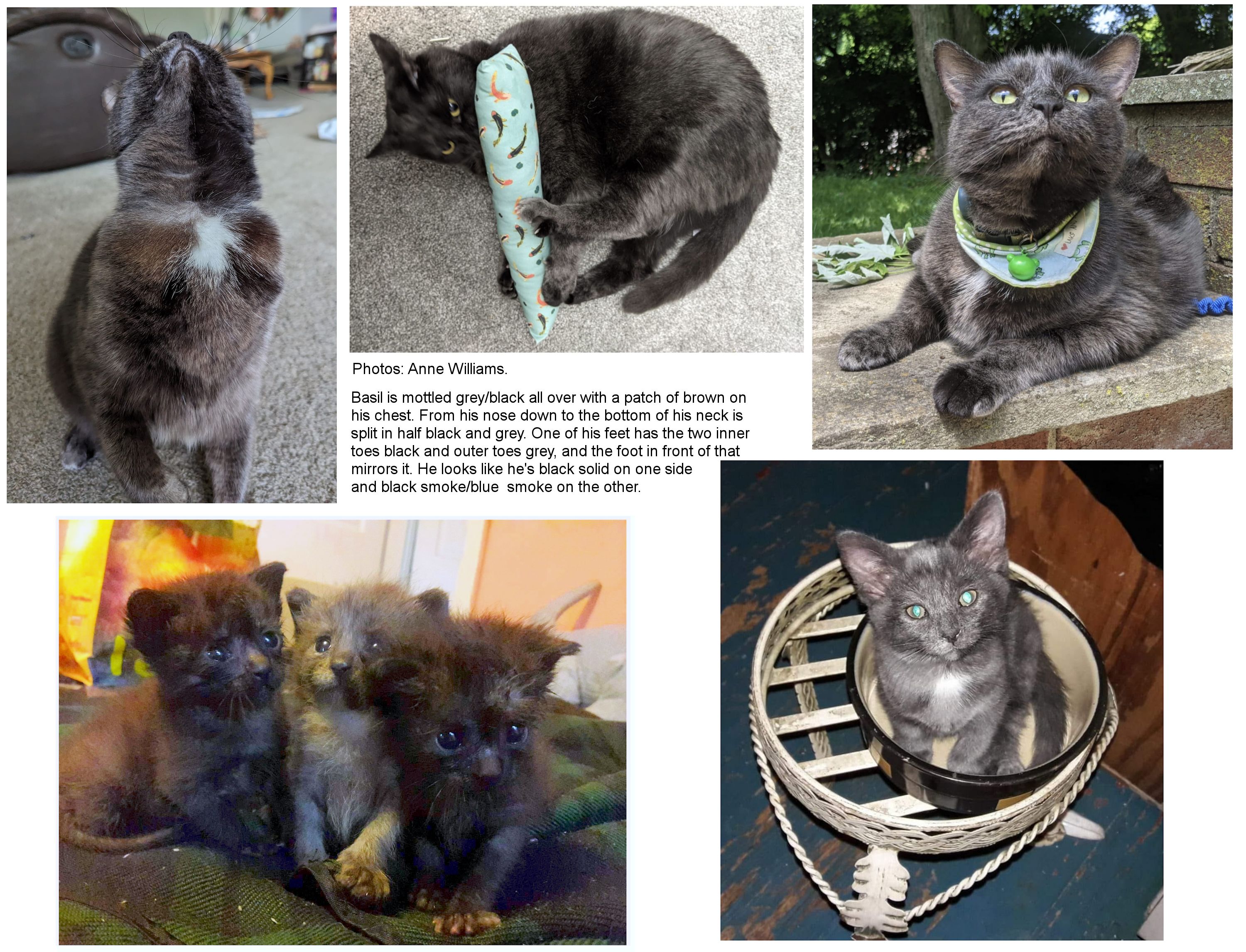
Josee Rodrigue wrote in December 2022: "After 3 months, sending 2 swabs sample and 3 samples of whole blood, I finally got an answer from UC Davis about my baby boy OSLO (Sherpa Cats Beyond Heaven)! He seems that our doubts are confirmed and he could possibly be a Chimera. Here is the explanation . . . He's not pointed for me as his body was not all white at birth. The dark part is chocolate, so chocolate torti and white. His body definitely isn't point but the fact that the colour on his nose and ear only developed later would suggest that the other embryo was pointed." Sherpa Cats Beyond Heaven sired his first litter at 10.5 months old. The mother was a blue tortie and white. The litter comprised 5 female kittens, 3 were red and white, 1 was blue tortie and white, 1 was chocolate tortie and white (white markings varying from a little white through to high white). This means Beyond Heaven breeds as a red (his X chromosome) and white and is genetically chocolate. His scrotum is chocolate coloured.
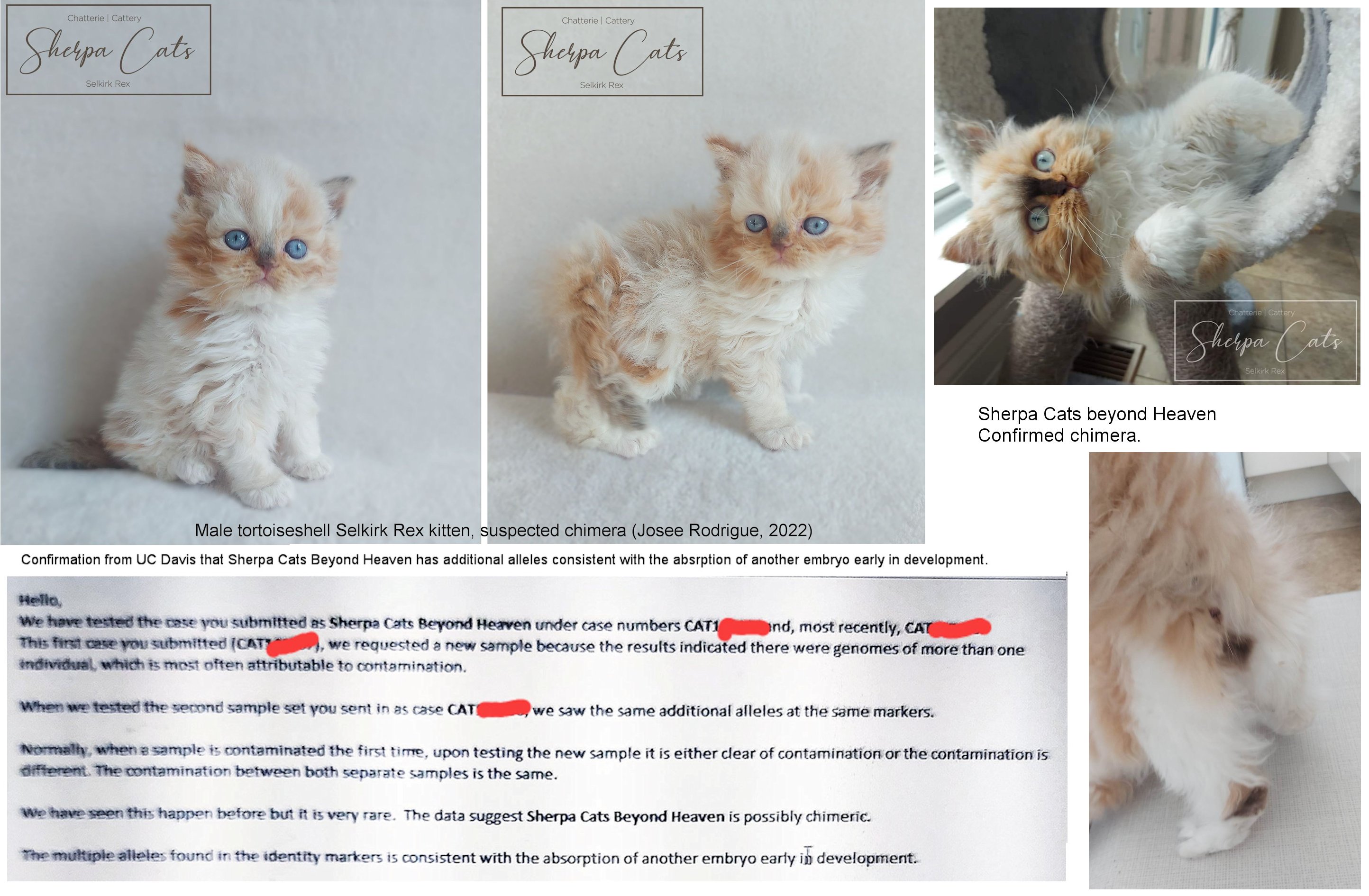
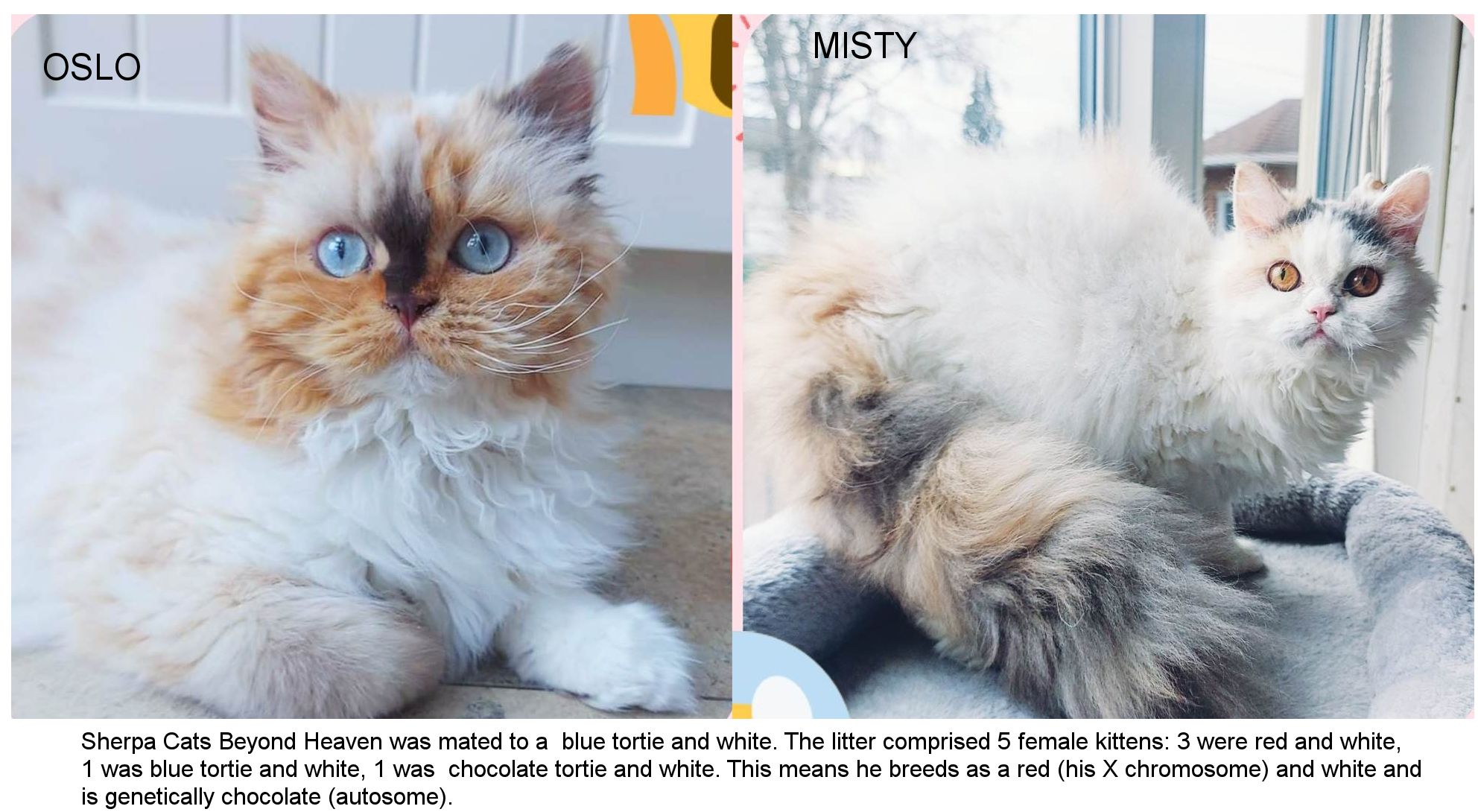
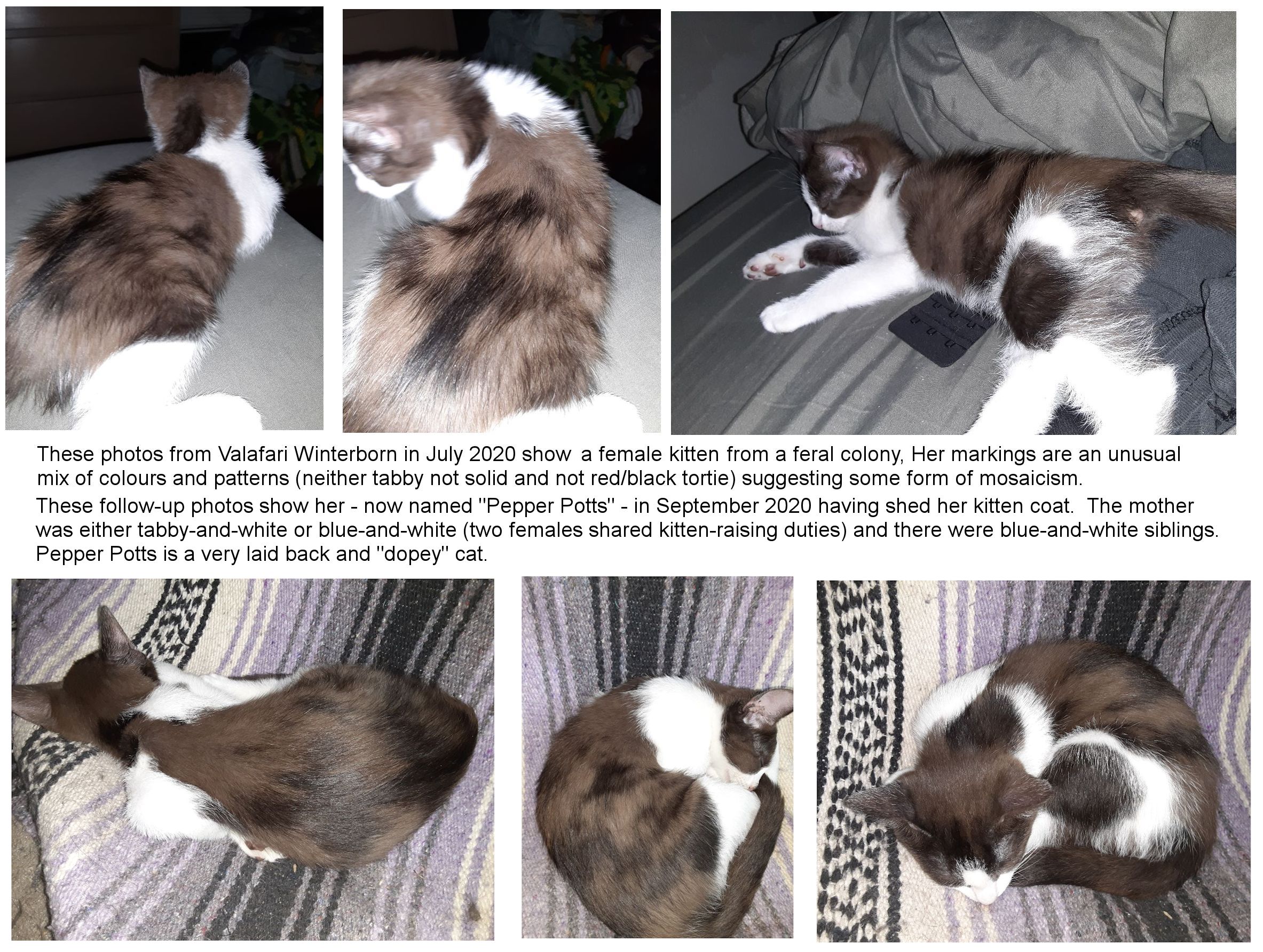
In spring 2007, Jeanne O'Donnell (Donegal Himalayans) had a litter from her Tortie colourpoint carrier, Donegals Irish Step Dancer and Flame point Himalayan male, CH Donegal's Irish Creme. She expected a mix of colourpoint and non-colourpoint kittens. However, one of the kittens was something more unusual. Resembling an opossum at birth, he was named Possum. Possum s face appeared to be all white, with the white extending in a streak over the back of his neck. His body was mostly a mix of red and black a tortoiseshell pattern that is normally only seen on females. Later on, his white face developed the red mask of a flame point Himalayan, but his eyes became the copper colour of a non-pointed cat. He had a black marking on the back of his head. He appeared to be a smoke tortie and white and it wasn t until the age of 4 months that Jeanne realised that Possum was male because based on the tortie pattern she had assumed Possum was female.
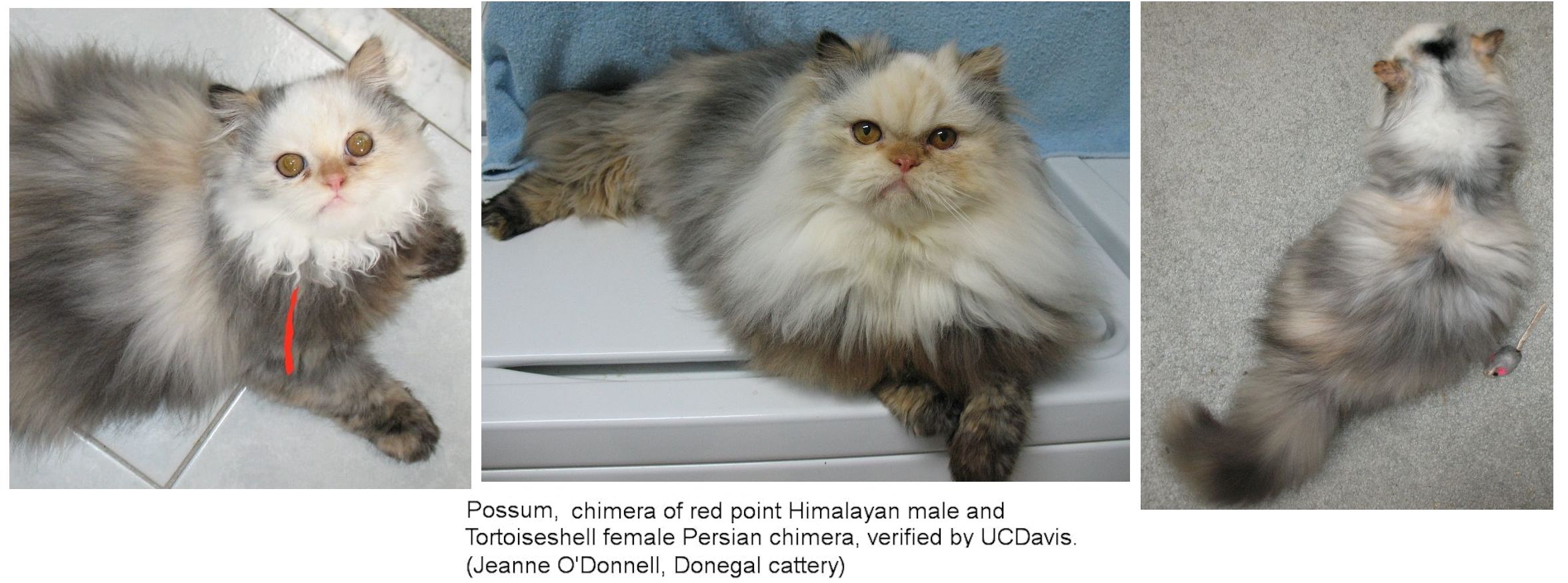
Once identified as a male, Possum s pattern was more of an enigma his face had his sire s flame point pattern (dense red colour), the blue on his body was a mix of Himalayan whitish body colour and black (he does not exhibit the dilution gene). He also had red on his body. Black and red only appear together where there are two different X chromosomes. Male genitalia meant he also had a Y chromosome. Despite his flame point face, his eyes were not the blue of a colourpoint. The mix of colourpoint and non-colourpoint meant that Possum had to be a chimera (2 fused embryos), with one of the embryos being a colourpoint male and the other being tortie female. The white colour is the body colour of the colourpoint pattern. He only has male sexual organs, coming from the male flame point embryo. DNA tests verified his chimera diagnosis. Jeanne decided to register Possum with CFA as an AOV male named Donegal's Tail of Two Kitties. He bred as a flame point Himalayan. Bred to the tortie point Who s Your Daddy (Hoosier), he sired 5 kittens, 2 of which were flame point Himalayan females. Possum is now a retired stud and lives permanently with Jeanne due to his uniqueness.
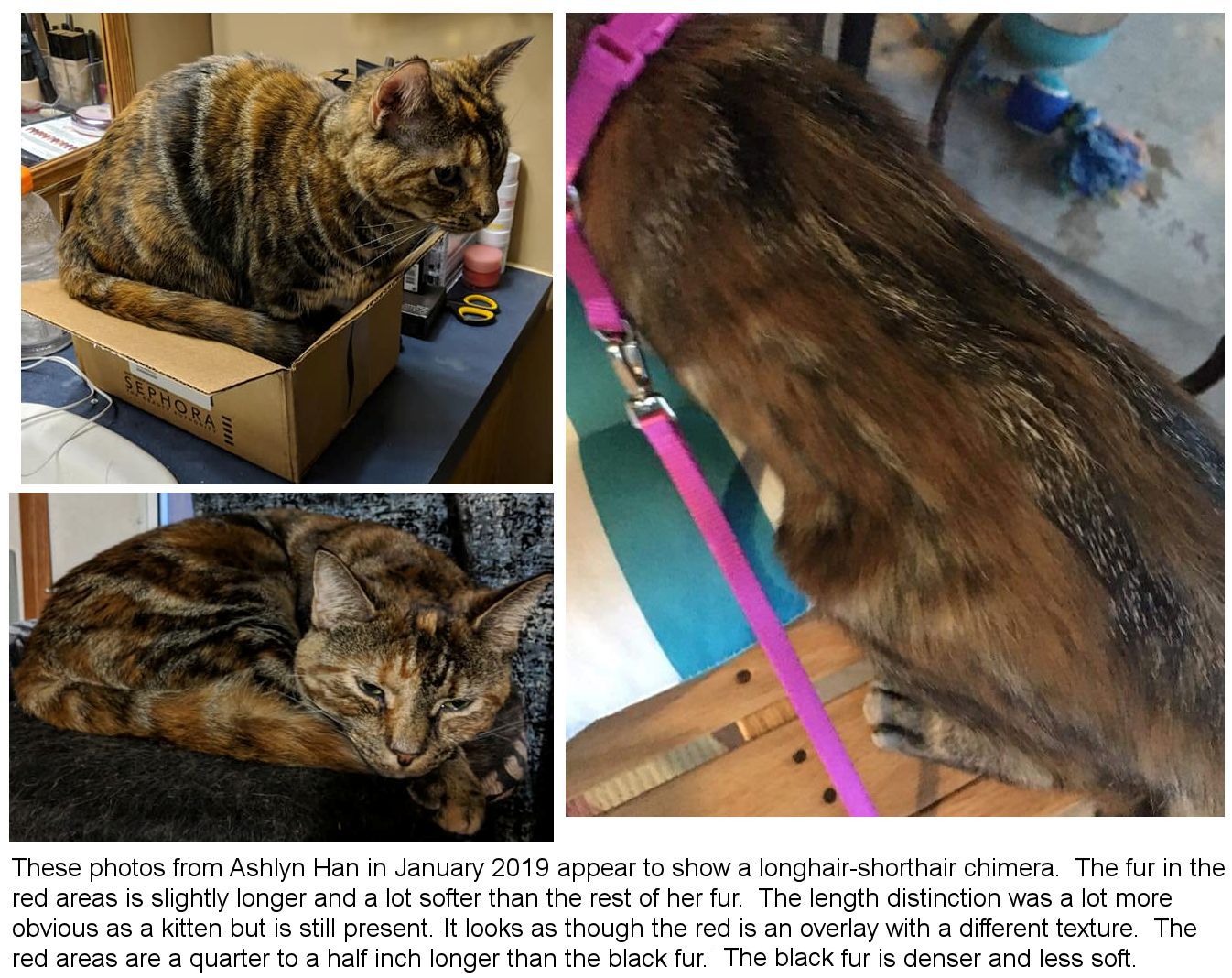
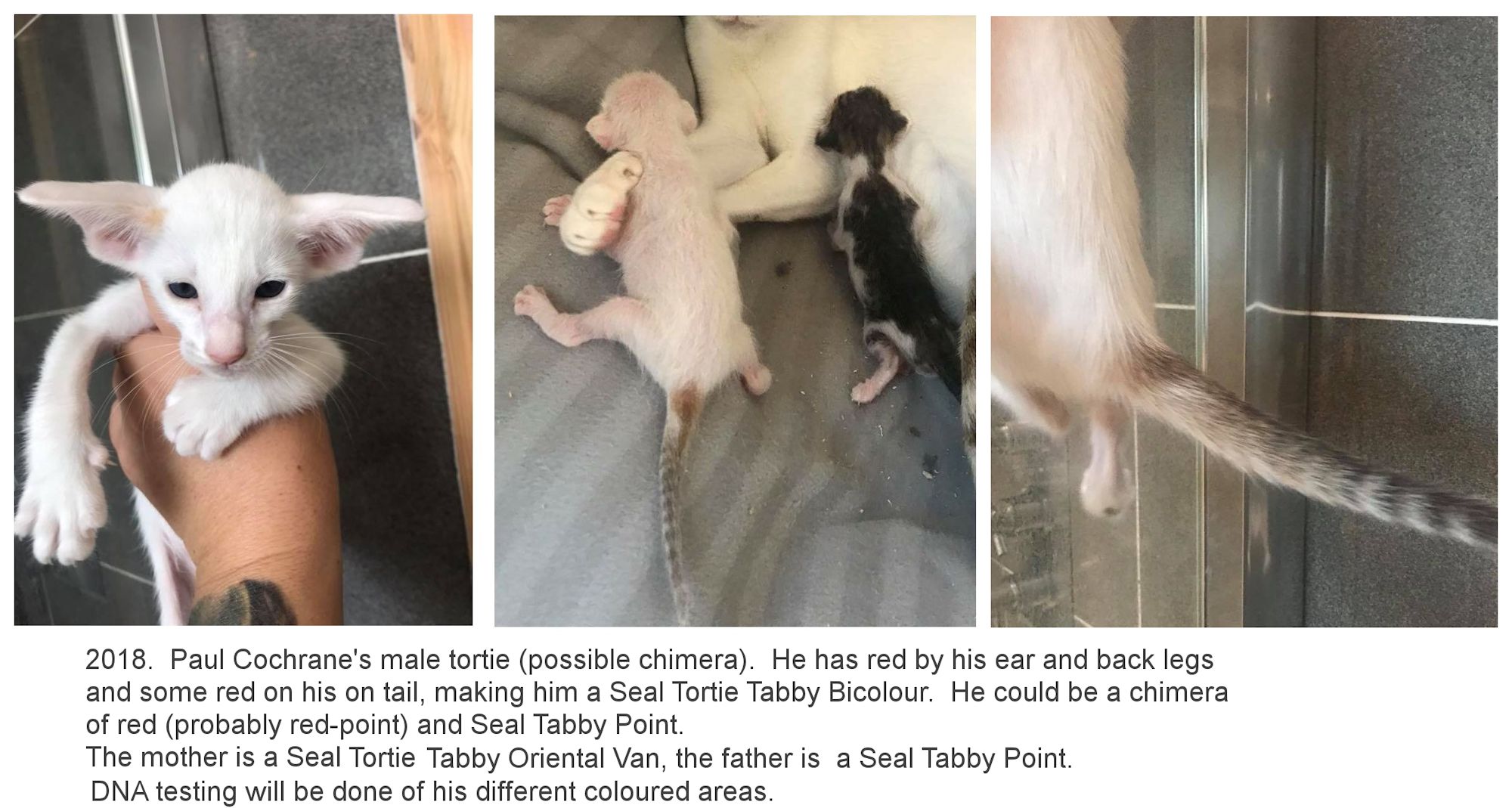
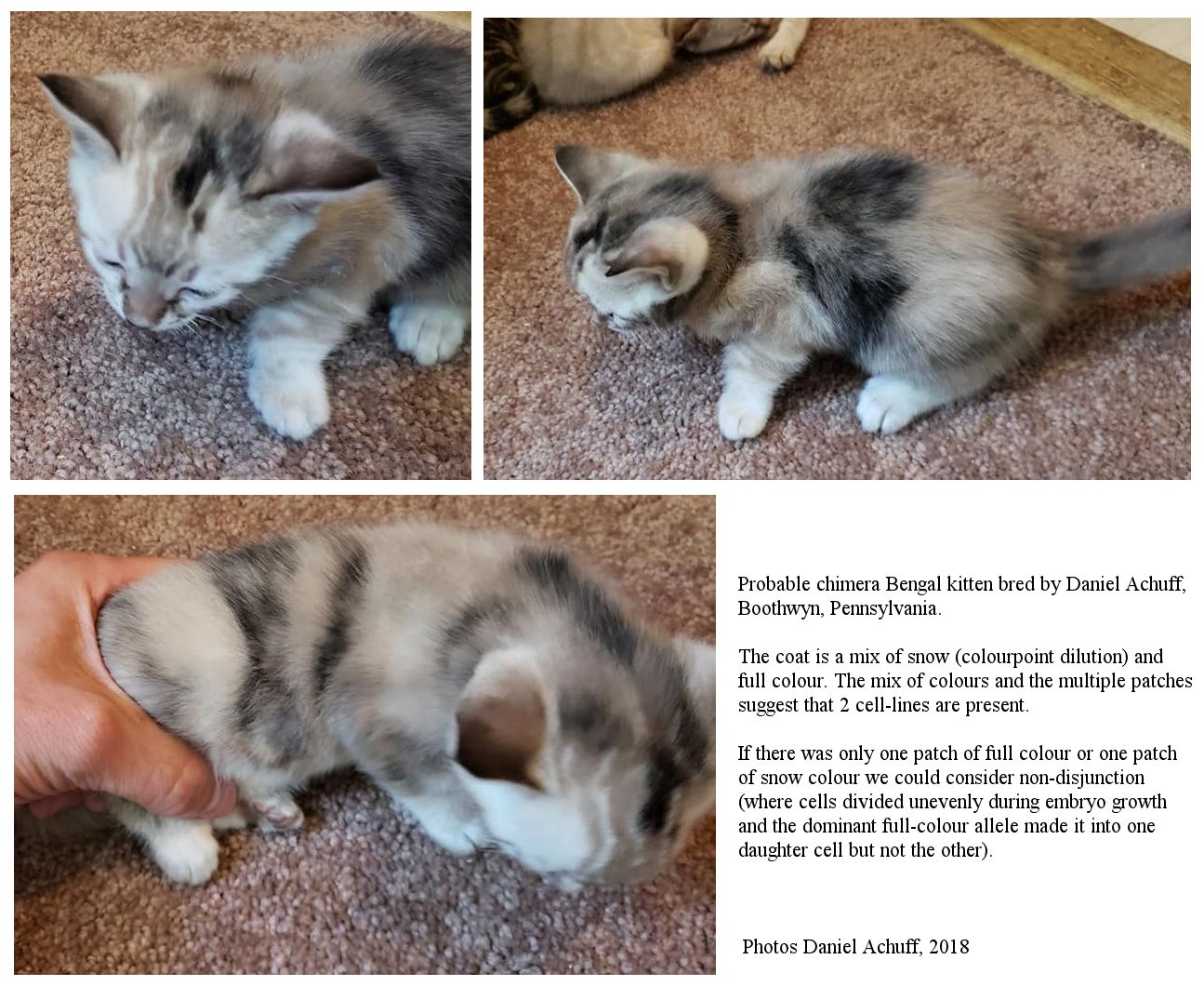
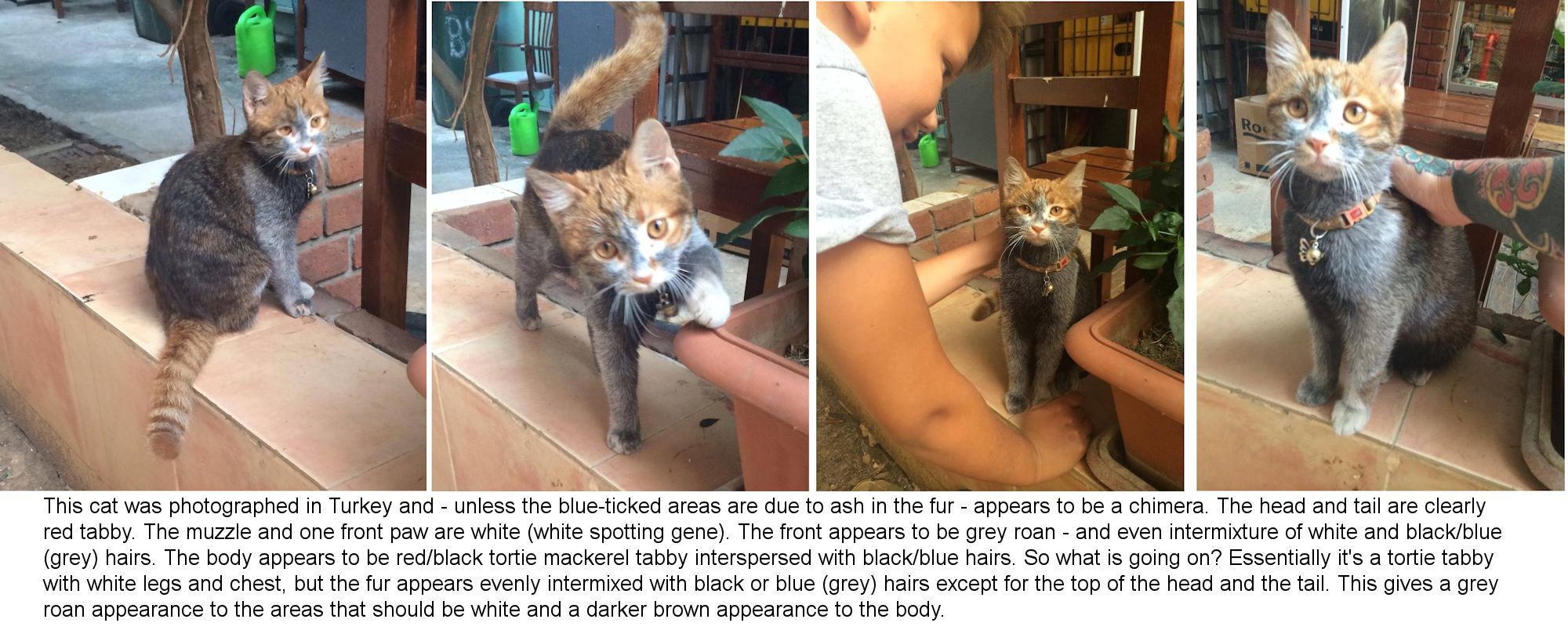
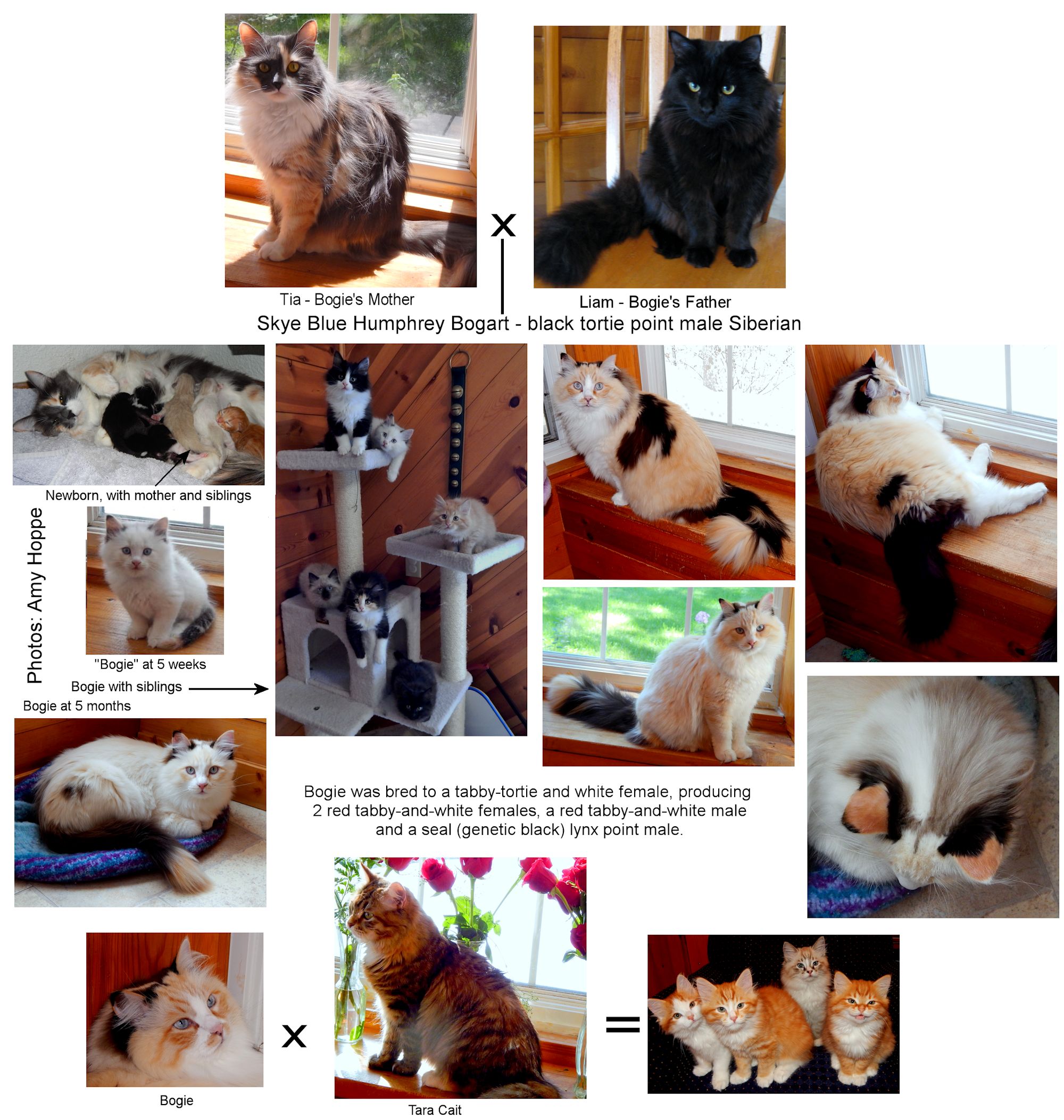
Skye Blue Humphrey Bogart is a black tortie point male pedigree Siberian owned by Amy and Glen Hoppe, Skye Blue cattery, Minnesota. Known as Bogie, he is a chimera and is able to sire kittens. Bogie was born in October 2013 to Tia (Perovskia Nikita), a blue cream tortie with white, and Liam (St. Thomas Pavel LX of Skye Blue), a solid black. This was Tia s first litter and all six kittens were different colours: Humphrey Bogart, "Bogie", seal tortie point male; Audrey Hepburn, tortie with white female; Catherine Hepburn, black female; Gregory Peck, seal point male; Sidney Poitier, black with white tuxedo male; James Stewart, red tabby male. To see if he was fertile (a chimera rather than XXY or sex-reversal), Bogie was bred to Cait, a brown torbie female, resulting in four kittens born in May 2015. The colours of the kittens showed that Bogie bred as a red point male. This means he is a chimera of red and black embryos, and his testes were formed from the genetically red cell-line. The kittens were: Ashley, seal lynx point male; Melanie, red tabby female with high white; Rhett, red tabby with white male; Scarlett, red tabby with white female. Red females have to inherit two X chromosomes carrying red, so one of those red-carrying X-chromosomes must have come from Bogie. Bogie's black patches are the signs that very early in his development he merged with a black embryo. Bogie had not been intended to become a stud cat, so after proving his fertility, he was neutered.
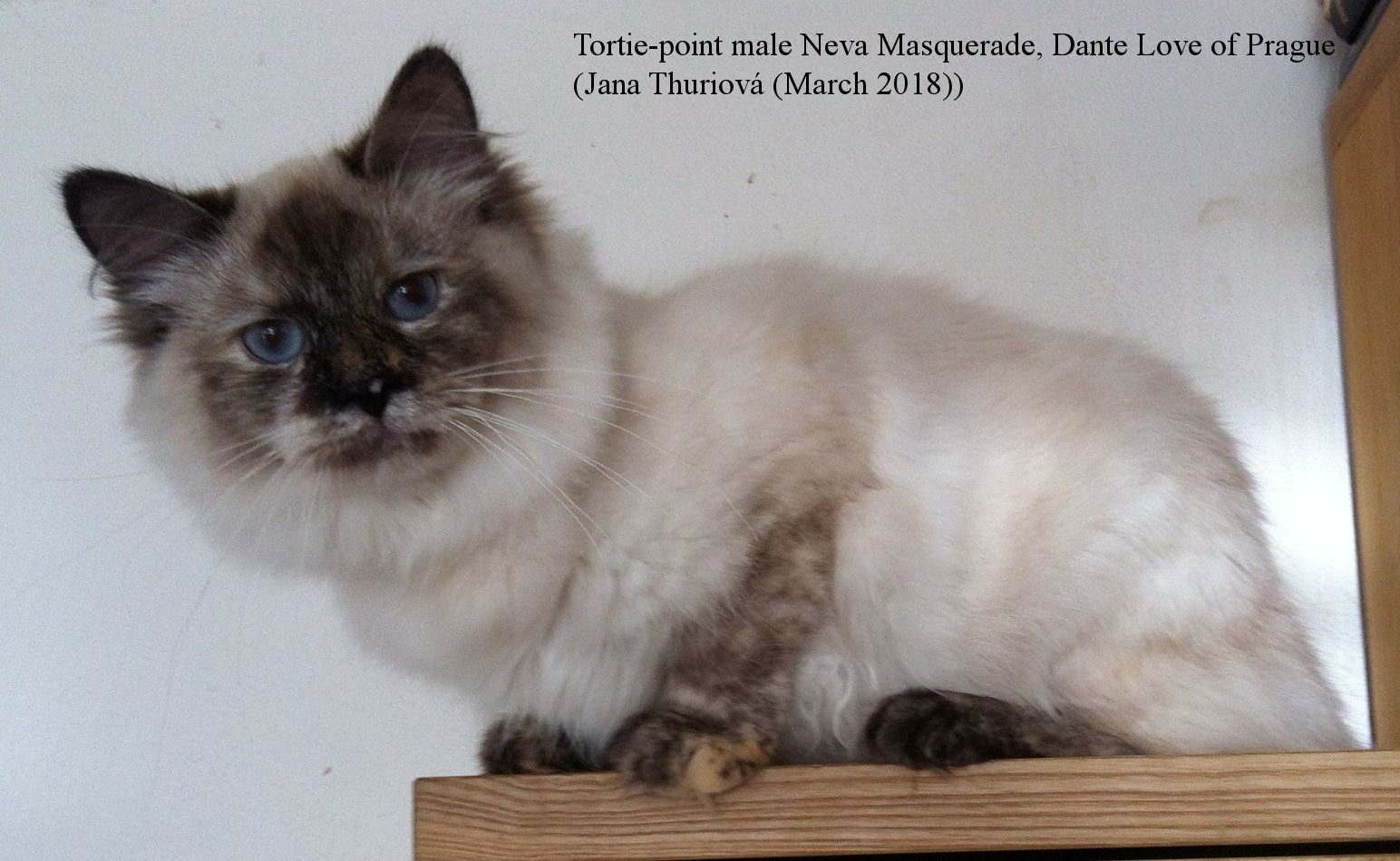
Jana Thuriov (March 2018) has a tortie-point Neva Masquerade, Dante Love of Prague (Czech Republic). He is unneutered and interested in oestrus females, but has not yet been allowed to mate. Up until he was 3 months old he was assumed to be female until he was bathed and Jane discovered he had lumps where females don t have lumps!
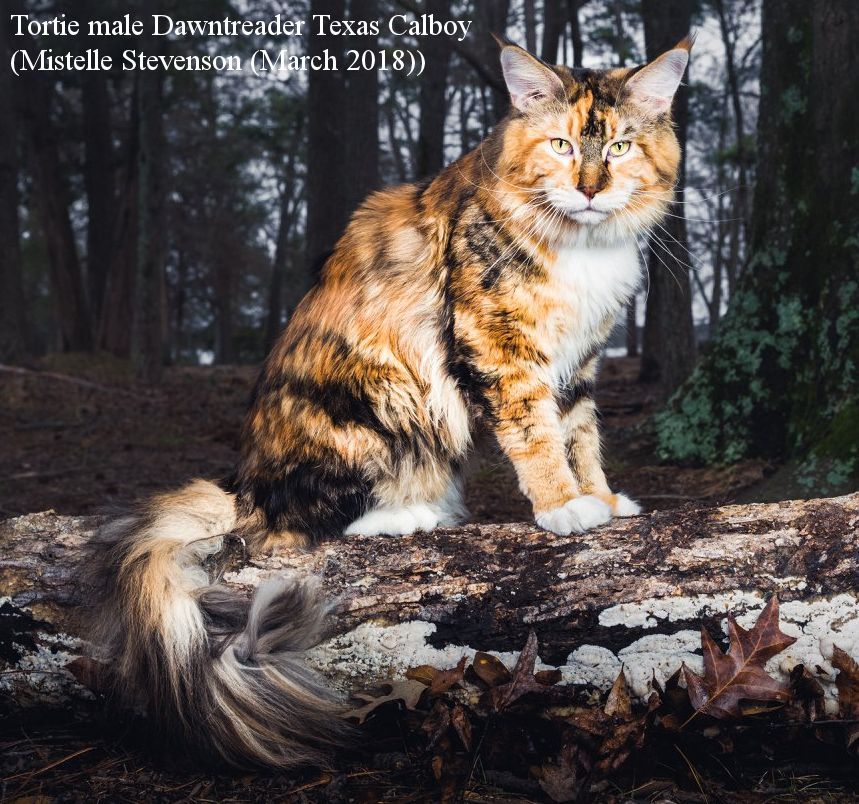
In March 2018, Mistelle Stevenson wrote about her rare tortie male Maine Coon TGC Dawntreader Texas Calboy. His mother is QGC Dawntreader Calyx (torbie and white) and his father is CH Islandcats Triton of US*Dawntreader (solid blue). Triton is the last breeding cat of Islandcats, an American line. Calyx is out of US* MyLuckystars Goldie x US*MyLuckystars Caspian of US*Dawntreader (polydactyl Maine Coon); Caspian is out of MetatronEyes Hakan of US*MyLuckystars. These are all prize-winning and champion ancestors. Dawntreader Calboy was born in January of 2017 and assumed to be female by his breeder, Mistelle Stevenson. Mistelle had decided to keep him for her cattery even before his true gender was known which wasn t until 3 months old, purely because everyone assumed this lovely tortie would conform to the usual rules and be female. Calboy s name comes from being a calico boy and from his mother s name, Calyx.
Prior to Calboy, the last tortie-and-white Maine Coon male to compete in shows was Solkatz Pretty Boy Floyd (red, white and blue) in the 1990s. Floid was shown in CFA and his owners fought to have an exception made to allow him into the ring, but he was never allowed to be a Champion. Calboy has been shown in both CFA and TICA. In CFA he was one ring short of his Championship, and received points towards his Grand, but CFA had a board meeting to close the loophole that allowed him to compete in the ring, passing a decision to block Calboy from completing his championship in CFA or claiming his Grand points. In TICA, he earned his Triple Grand Championship that same weekend.
Because Mistelle thought he would be infertile, she naturally left him out with all of her cats. Little did she know that this would end up resulting in multiple pregnancies at once. Calboy was the only male that had access to those females. Usually chimera males only breeds as one colour. For example, Pretty Boy Floid bred as a red. When bred to a black smoke female, Calboy sired a smoke tortie, which meant he was breeding as a red. But when bred to a red silver female, Calboy sired a silver torbie, which meant he was breeding as a black. Barring a totally new mutation, the only way he could be breeding as both a red and a black is if his testes are a mix of cell-lines from two fused embryos.
Mistelle sent cheek swabs for initial DNA testing to distinguish between klinefelter syndrome and chimerism. Testing normally requires these plus hair samples and blood, because sometimes a chimera is mostly one cell line, with a few cells of the other cell line in isolated places. However UC Davis found Calboy is a true chimera from just those swabs. She also sent of swabs from the two female kittens kittens for parentage tests. These confirmed Calboy to be the sire of both. He breeds as both red and black, with and without white, carries dilute and non-agouti. He has also sired a solid (self-coloured) blue male and he throws classic tabby, as well as solid (self), when bred to a female that is solid (self). He is the only known male calico that breeds as a true calico.
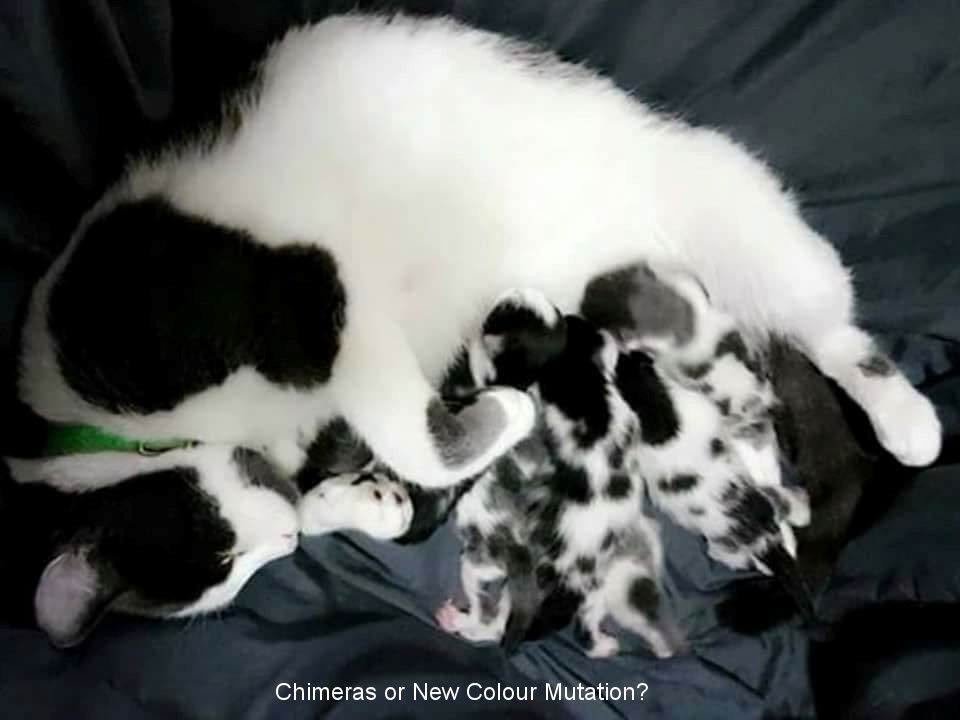
This female and her kittens are enigmas. The mother cat is patched black-blue and white, a mosaic pattern of dilute and non-dilute that is impossible except in somatic mutations (like Narnia de la Grace) or chimeras where there is a mix of black cell lines and blue cell lines. She should not pass on both colours to her offspring. However there are 4 kittens, also patched black-blue and white. The father is unknown. Could a black embryo and a blue embryo (either or both having white spotting) have fused just after fertilisation and then split into 4 parts, each of which has developed into a chimeric kitten? Or is this a newly colour/pattern emerging mutation? It wold take some experimental matings to work out what is happening. The solid patches of black on the kittens, mostly in the head region (which is odd in itself), rules out silver-tabby and white.
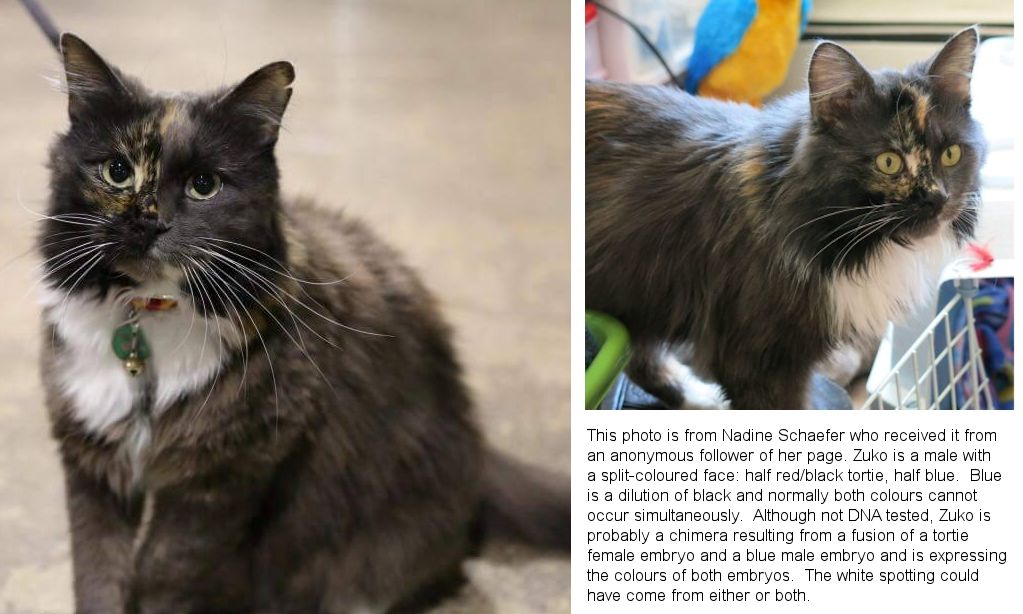
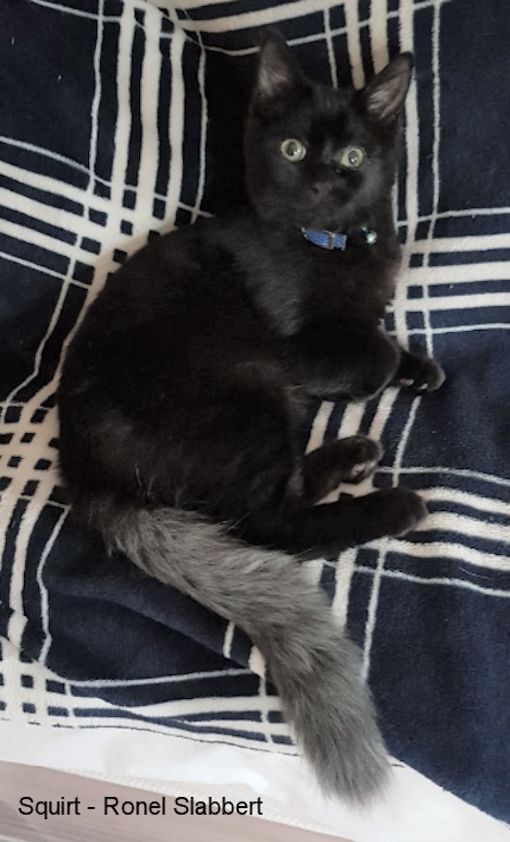
Squirt (above) has a good claim to chimerism because he is a mix of black shorthair and blue semi-longhair. Not only is he an impossible mix of colours in distinct patches (his tail, plus a patch behind each ear), those patches are an impossible mix of fur types. Squirt was hand-reared from 3 weeks old by Ronel Slabbert in South Africa.
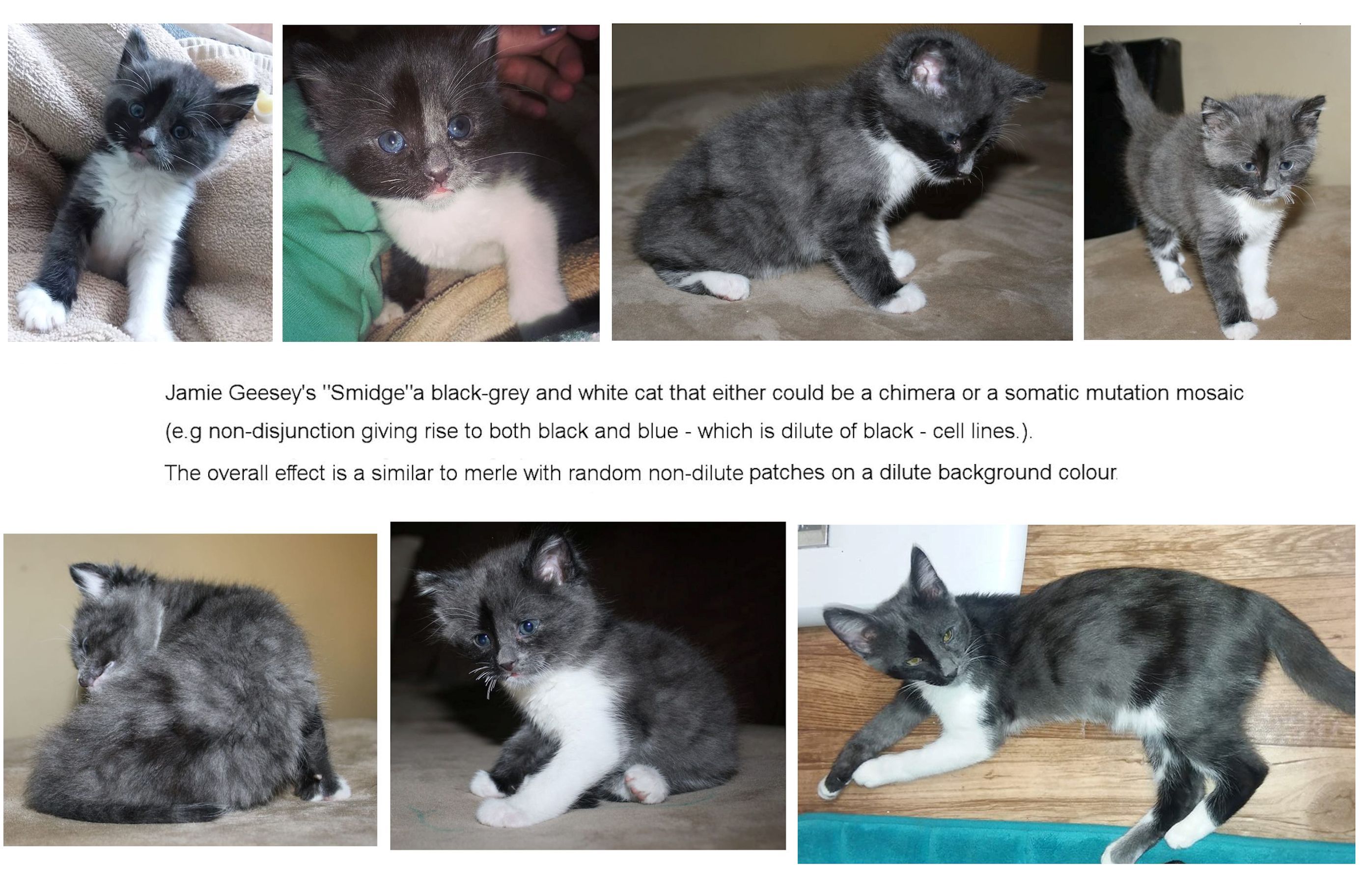
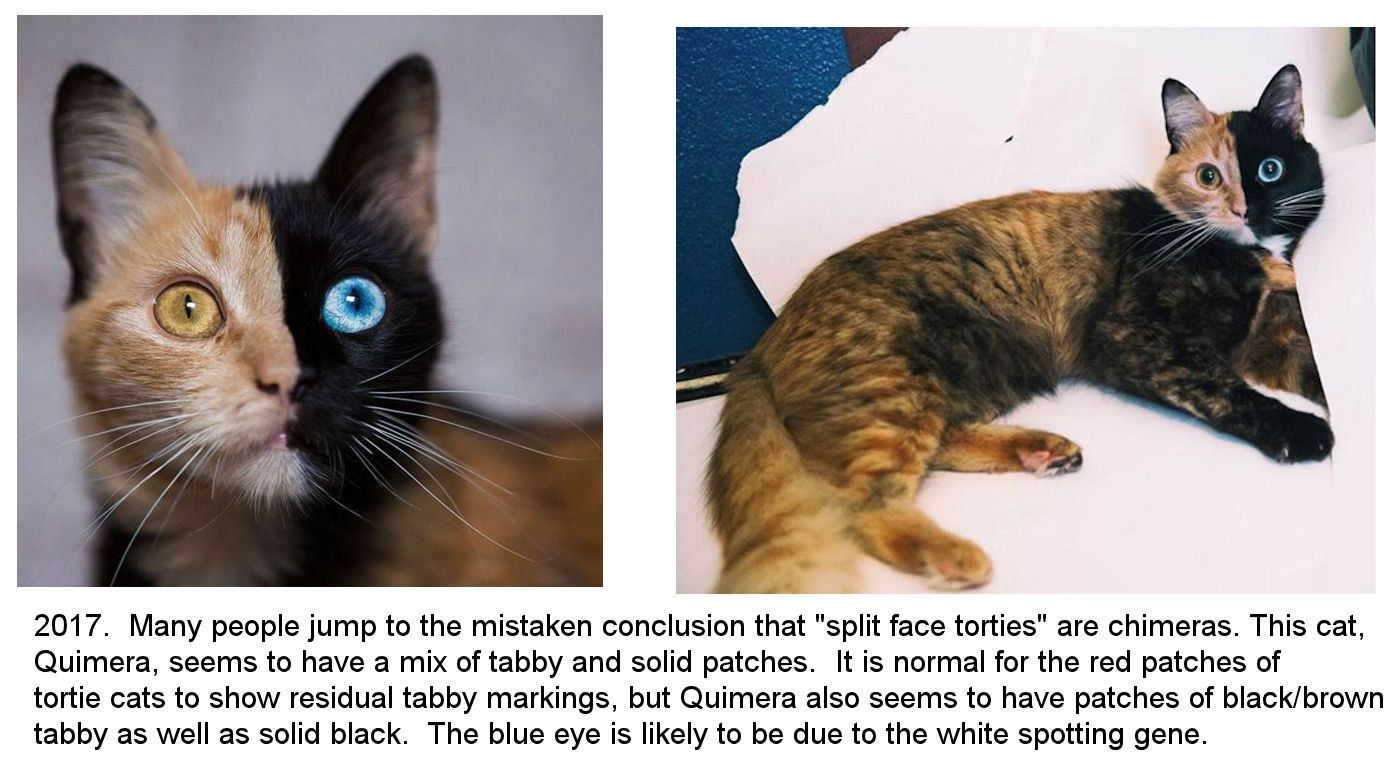
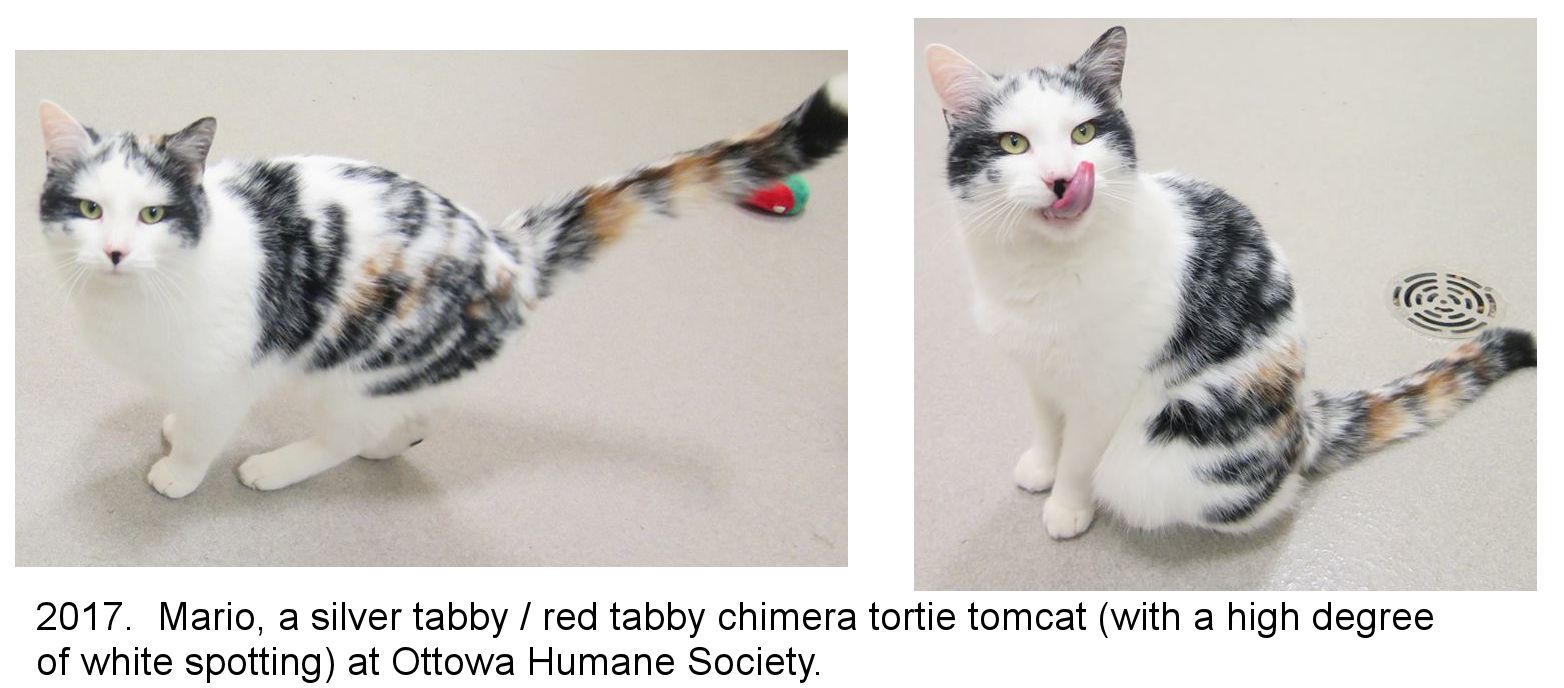
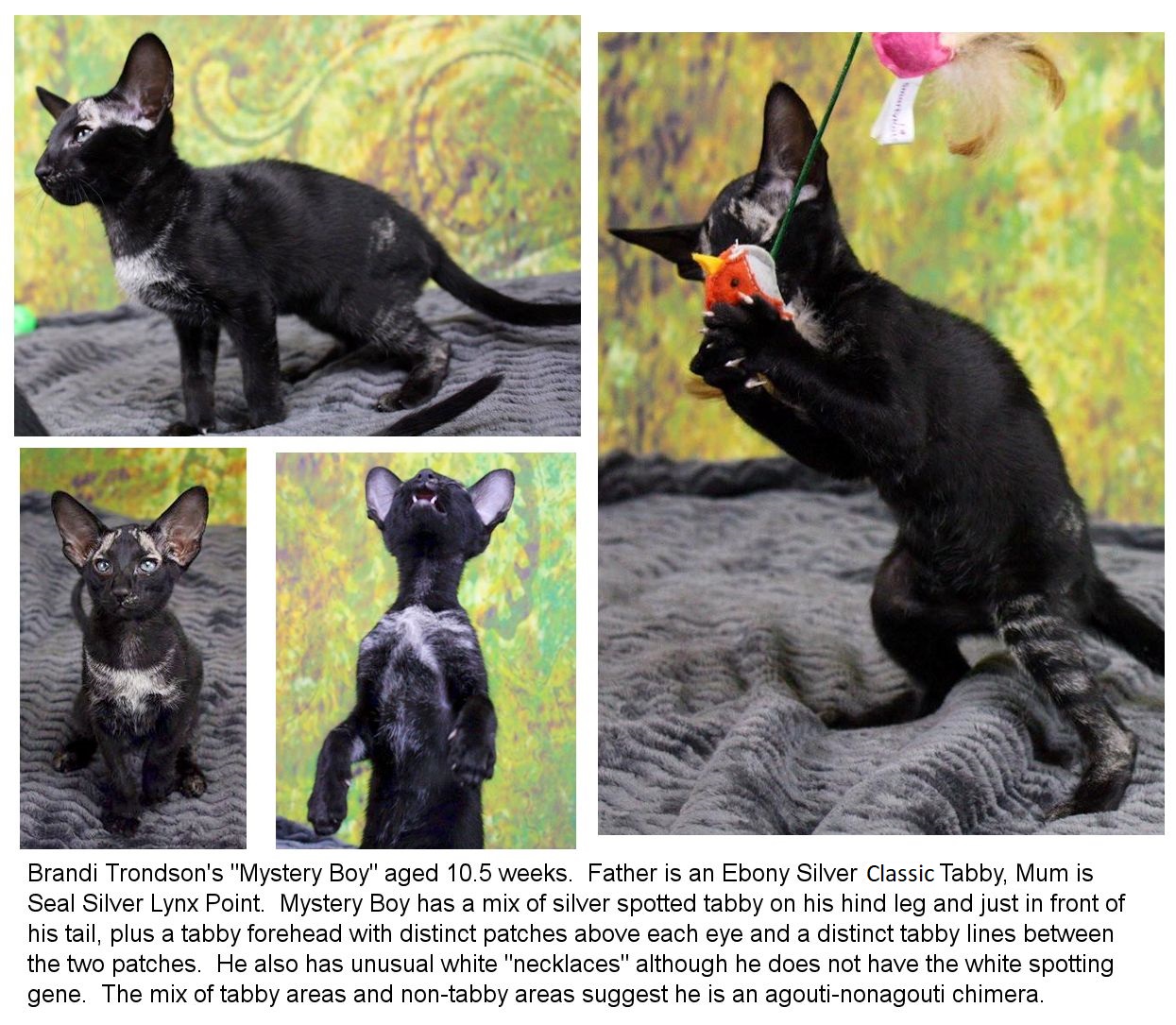
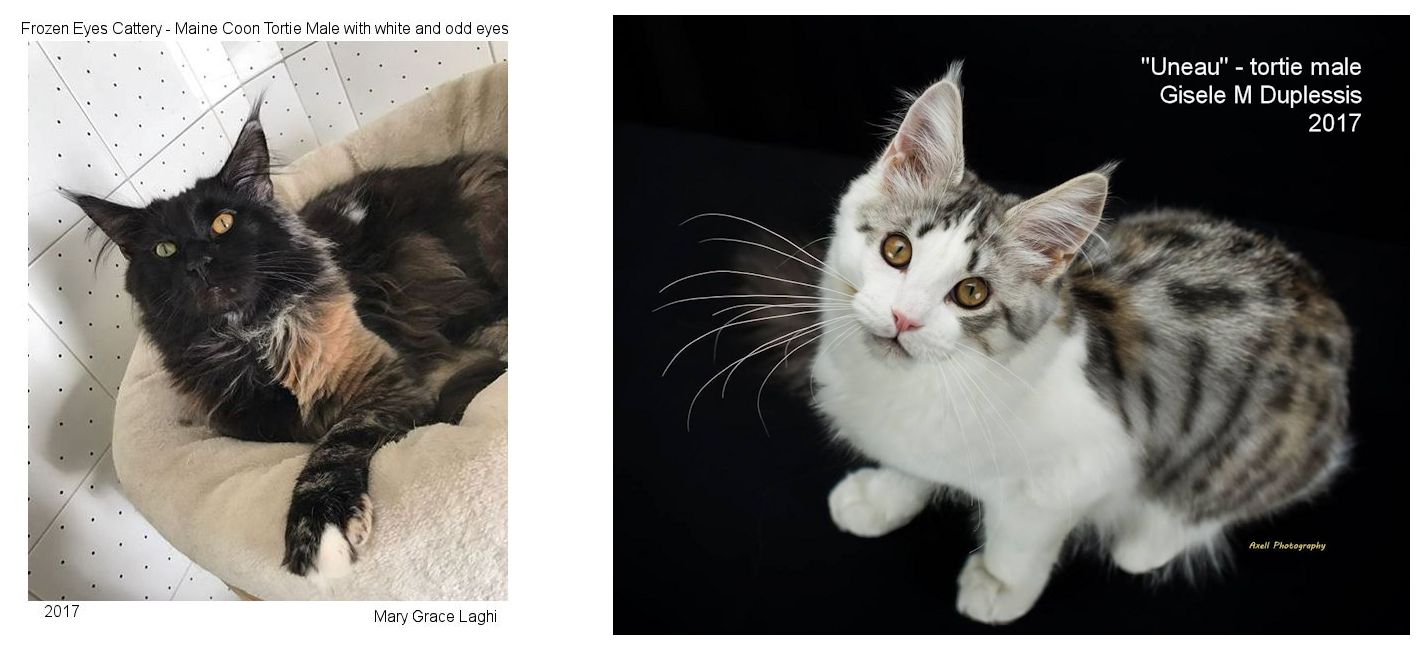
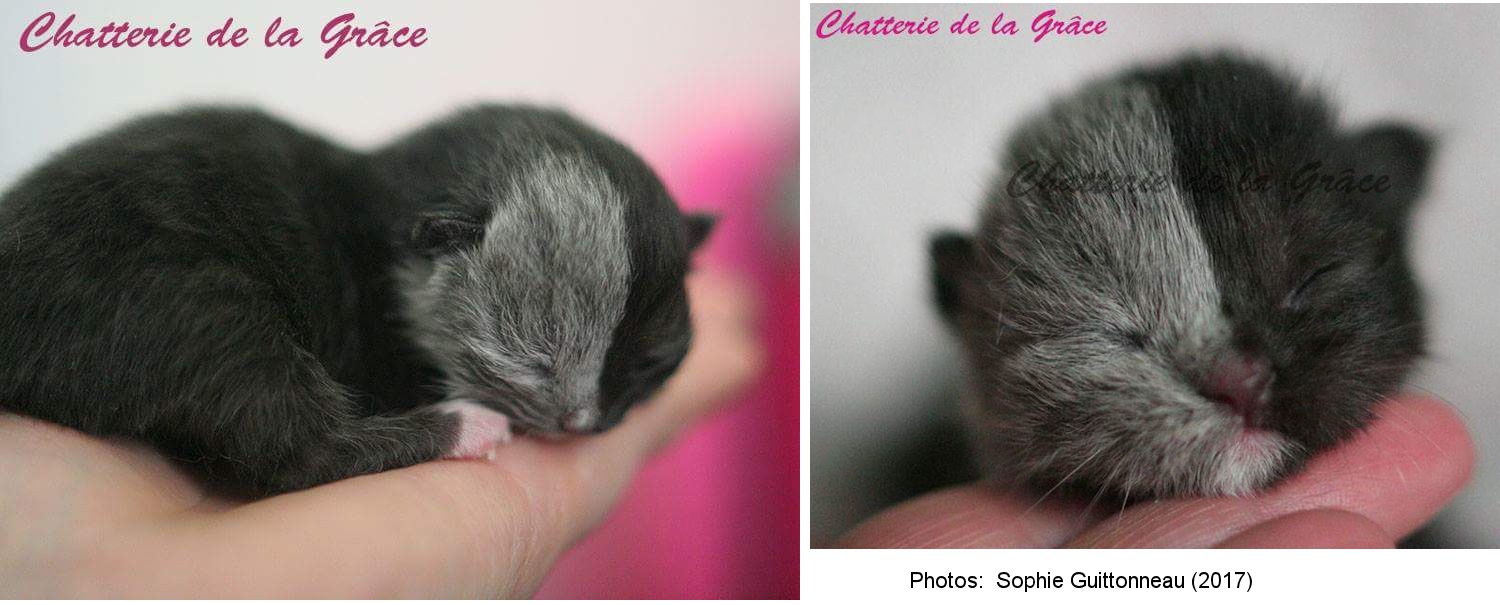
These photos of a black-and-blue mosaic (from Sophie Guittonneau) are of Narnia, a famous French male cat of the "Celestial" breed. This mix of dilute and non-dilute can occur due chimerism or to "mitotic non-disjunction." When a cell divides into two cells, sometimes the DNA doesn't get evenly distributed into the two new cells. An allele (in this case, the dominant D allele for dense colour) may have been left behind in one of the cells. That means the other daughter cell has got the recessive allele (for dilute colour) and that is what is expressed in that daughter cell and in all of its daughter cells when it divides to form a clonal group of cells. DNA tests confirmed in 2018 that Narnia is not a chimera. His mother is blue, but his father does not carry the dilute (blue) gene which means they could not have produced a blue embryo. Narnia is an enigma. Some other mutation, or perhaps epigenetics, has caused Narnia's dilute colour patch.
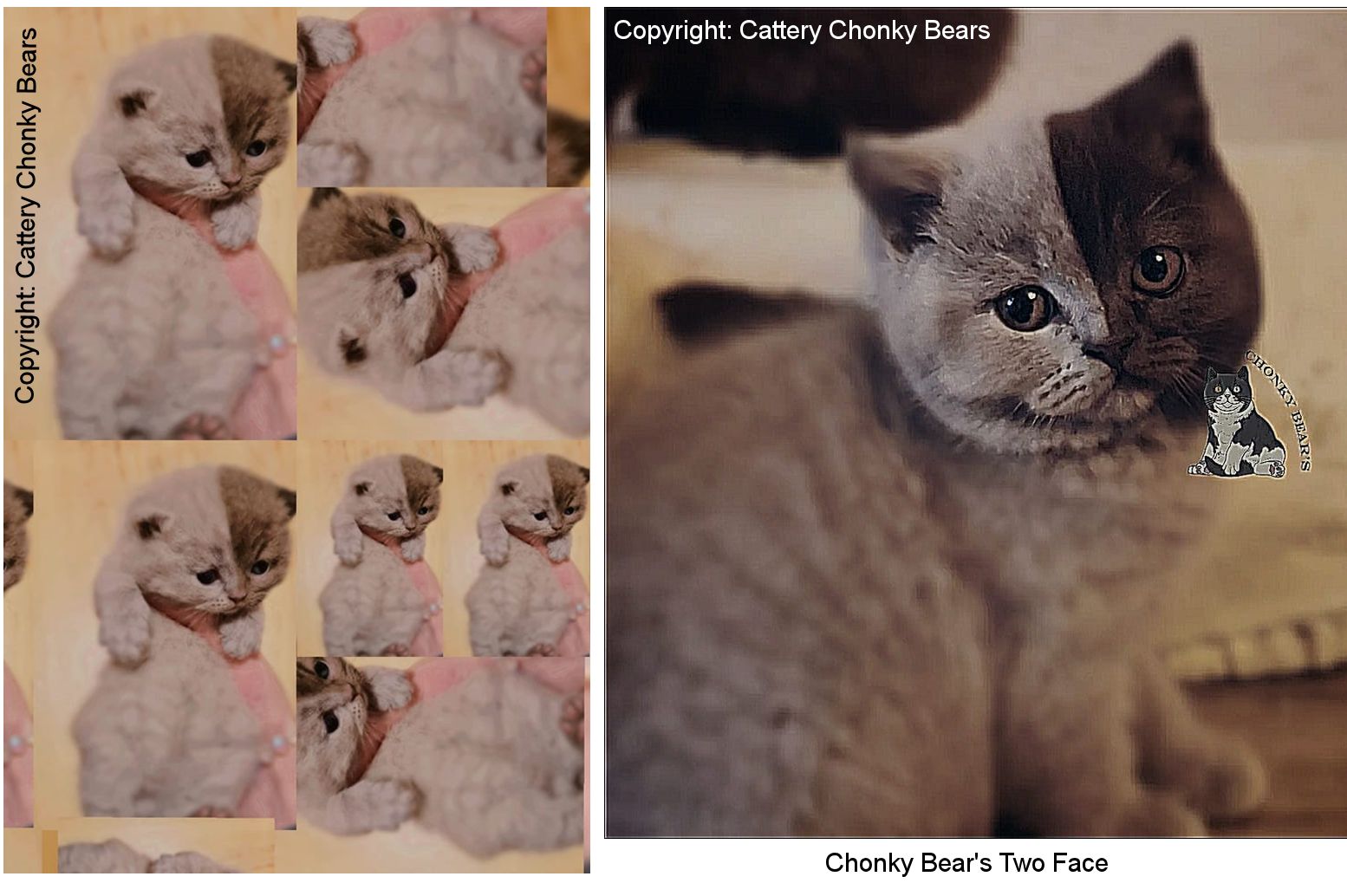
This British Shorthair cat, Chonky Bear's Two Face, is from Cattery Chonky Bears in Gottingen, Germany, which is working with one of the genes for dominant blue eyes (DBE). Two Face has latent blue eyes, meaning she has the DBE gene but it is not expressed due to interactions with other genes. Her mother is chocolate, her father is lilac (chocolate + dilution gene), the kittens were lilac, chocolate and then this girl who is lilac with a half-chocolate colour face. She is not tortoiseshell and this mix of colours - dense and dilute both expressed - is genetically impossible. This is a similar appearance to Narnia - black (dense) and blue (dilute) - which raises the question of a link to the DBE genes. Both of thee DBE genes are PAX3 mutations.
Two Face's chocolate mother is an F3 DBE. In the past 2 years the same parents had produced 2 kittens in a single litter that had similar marking, but they both died within a few days. Back in 2018, the mother s sister also had a similar special marking, but was spayed and sold as a pet cat. This indicates something genetic because 4 cats from the same lineage had a similar appearance and impossible mix of colours.
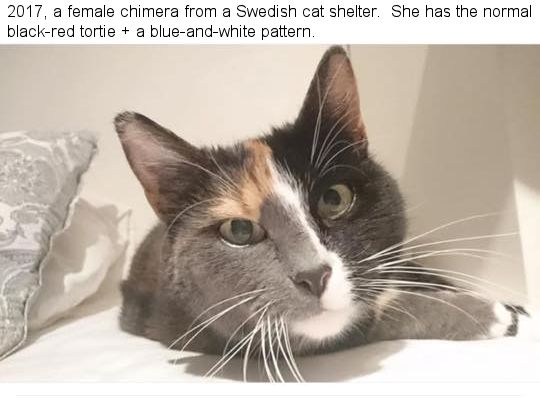
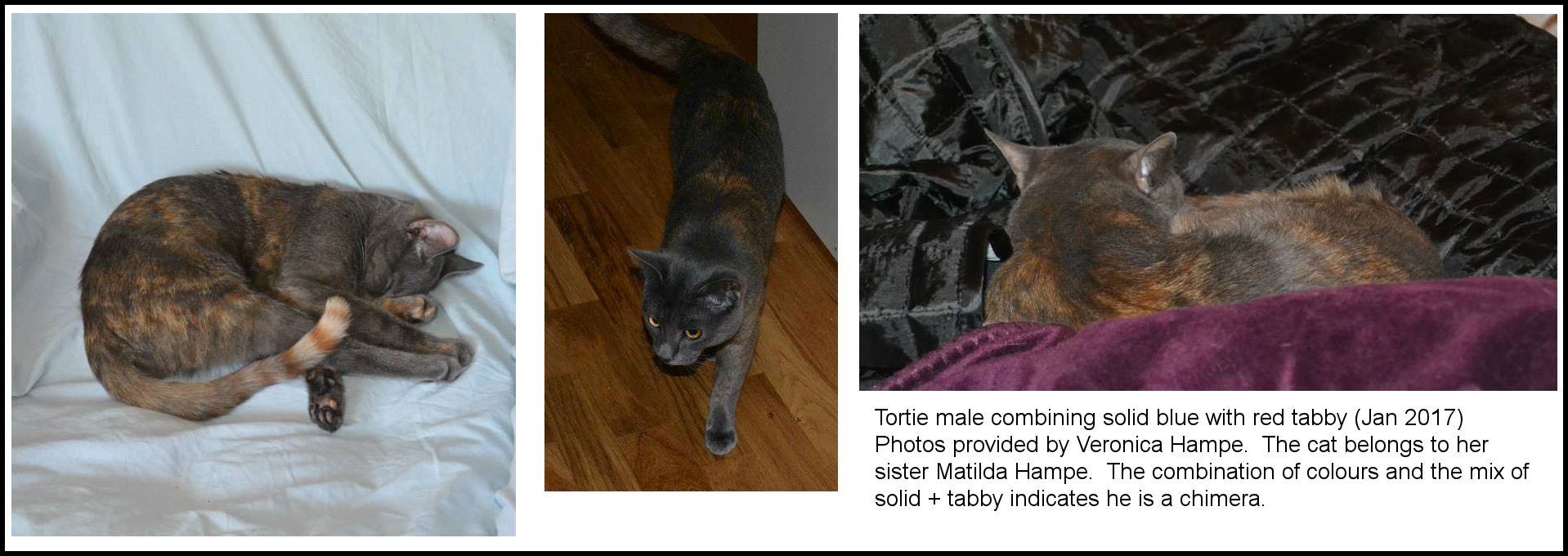
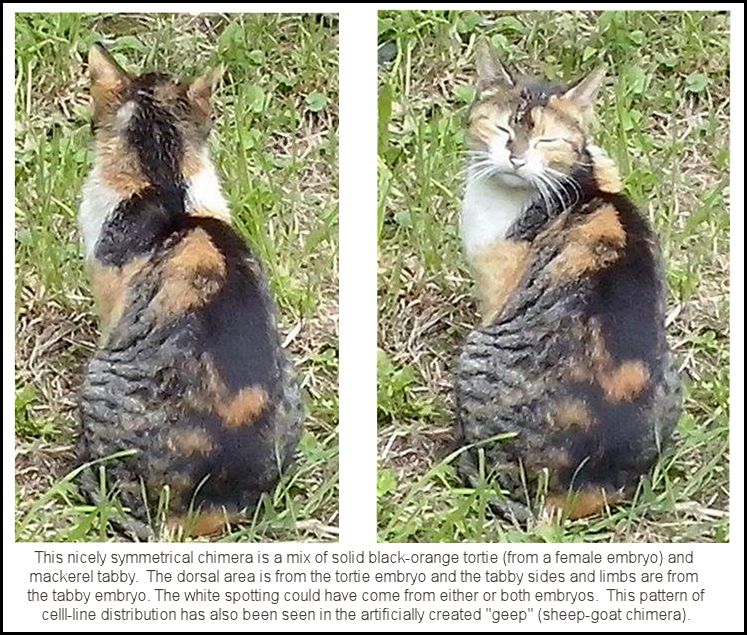
Above (photos by Svetlana Lalovic) is a very obvious chimera. The dorsal strip is a normal solid (non tabby) black-red tortie pattern while the flanks are mackerel tabby.
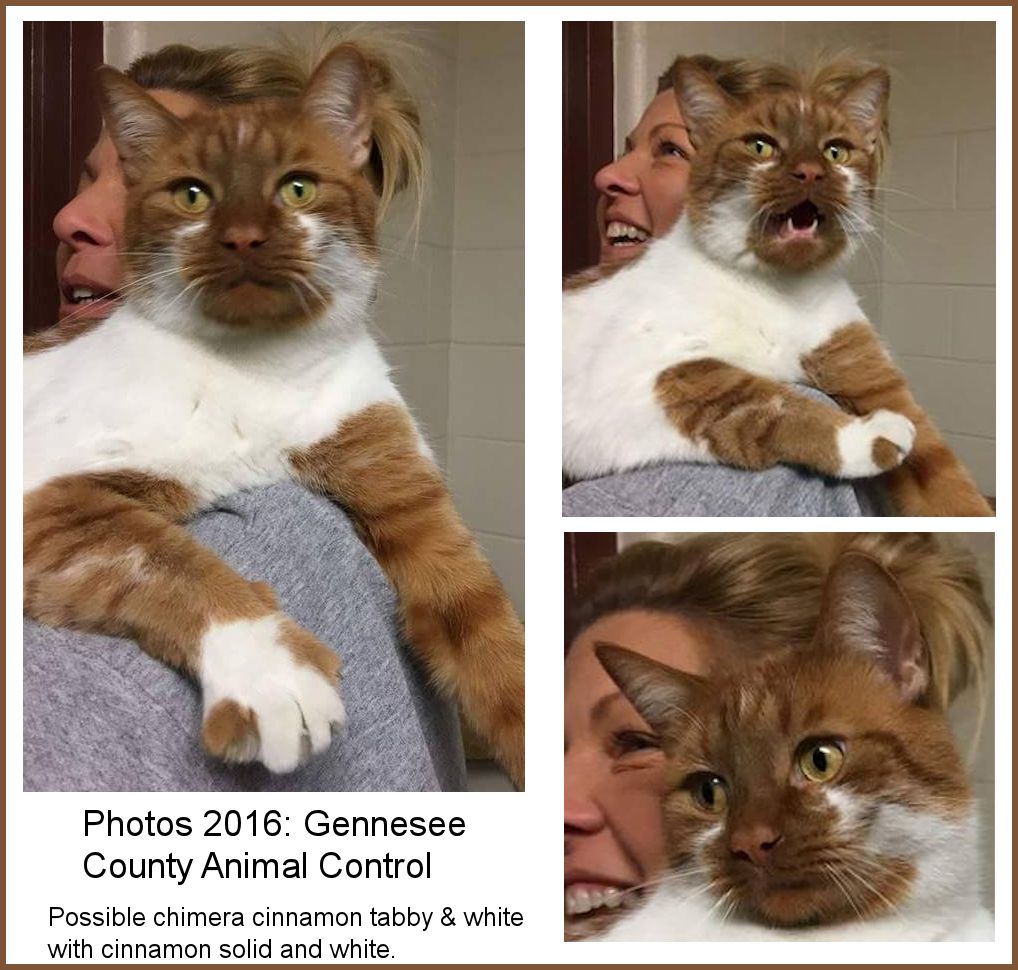
Above appears to be a chimera of a cinnamon-tabby-and-white with a cinnamon-and-white. The muzzle and nose leather are typical of a solid colour (non-tabby), but the foreheand and legs are very definitely tabby marked, as is a patch on the back. The distribution of the white colour is also unusual - the torso is white (barring a small patch on the back) and the head and legs are coloured. It's impossible to confirm this hypothesis without blood tests, but the unusual pattern of white plus the mix of cinnamon tabby and solid cinnamon suggests chimerism.

BJ Andersen, Executive Director of Willamette Humane Society provided these photos of Ariel and Bridgette who appear to be chimera twins. Their colours are red classic tabby (a non-dilute colour) and what appears to be either lilac/lavender (a dilute colour). The only known way a cat can display both dilute and non-dilute is through chimerism. The variation between the photos is due to the different lighting condition. Both have similar distribution of the red tabby and lilac colours. This suggests that two fertilized eggs fused and, having shared cells between them, later separated into twin embryos.
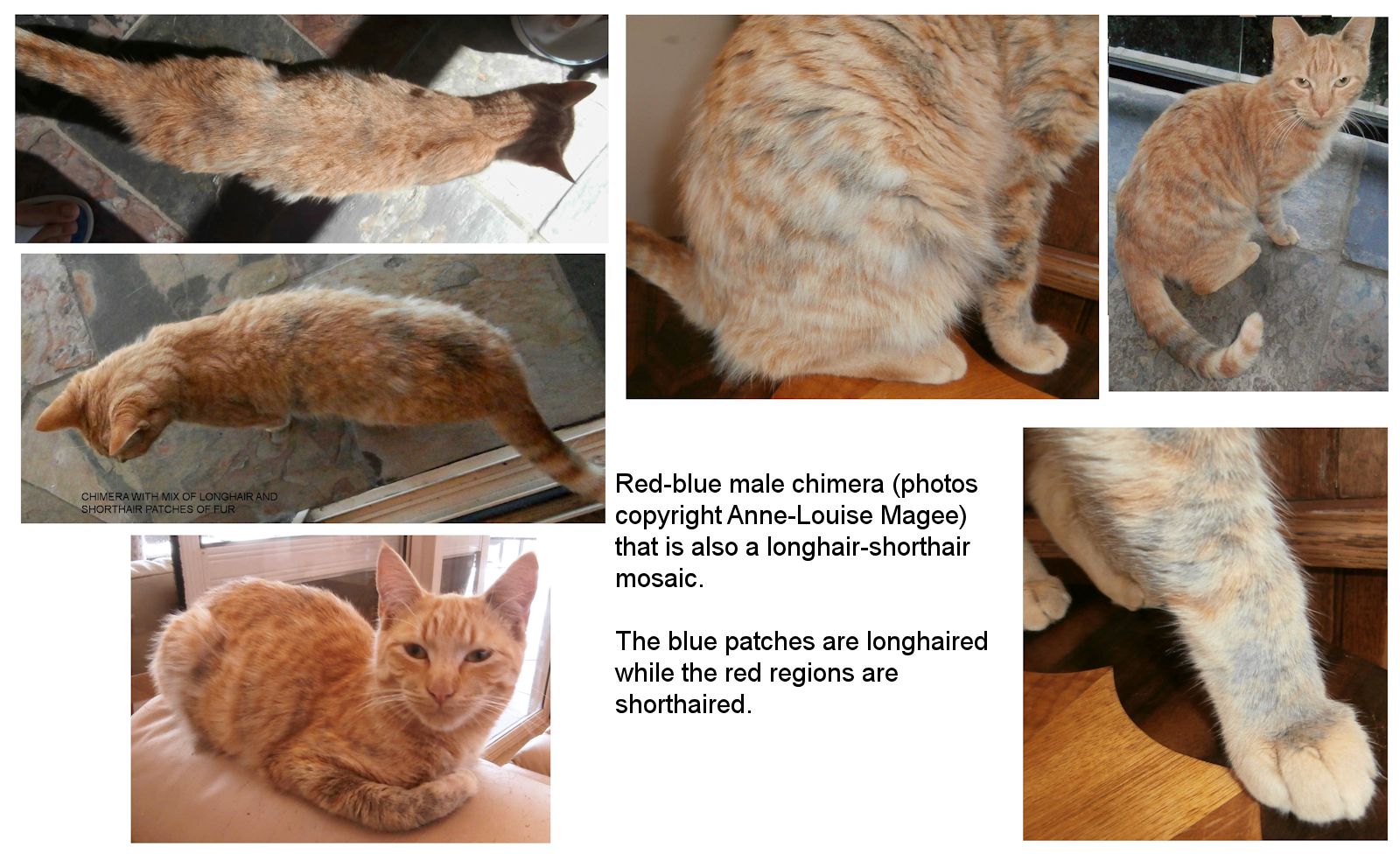
The different cell lines can give rise to different fur types as well as different fur colours. Anne-Louise Magee provided these photos (2014) of a tortie tomcat cat where the blue regions are longhaired and the red regions are shorthaired.
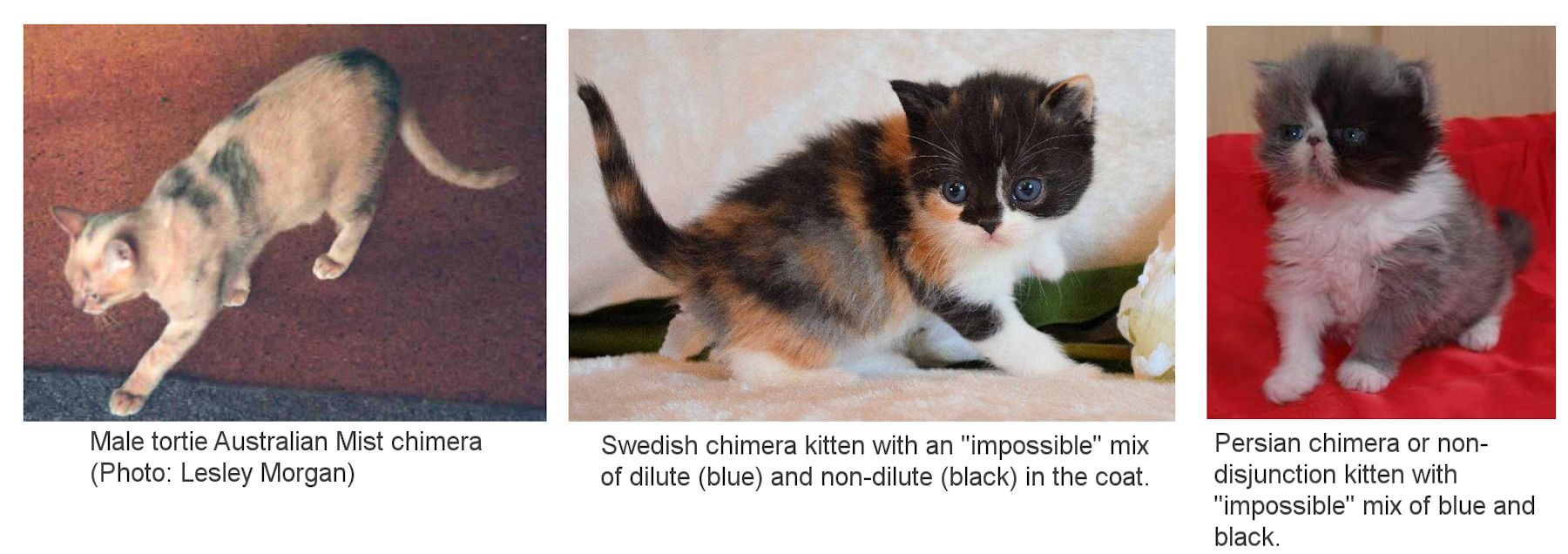
Possibly the most famous tortoiseshell male cat is Solkatz Pretty Boy Floid, a pedigree Maine Coon, born Nov 1996 in Bremerton, Washington, USA. Floid is a triple genetic anomaly: calico male, mixed dilute and non-dilute colours and fertile! Floid was initially thought to be a dilute calico male (blue, cream and white) which in itself is unusual enough. However, the cream portions of his coat turned out to be red i.e a non-dilute colour. This is also very unusual as the dilution gene which gave him the blue (grey) colour should have converted all red portions into cream. Finally, Floid is fertile. Floid is a chimera - the result of two fertilized eggs merging into a single embryo. On a genetic level, different portions of his coat (of his whole body in fact) actually belong to different cats. Although a very nice Maine Coon and the sire of some excellent offspring (none of which are dilute, therefore his testicular tissue is from non-dilute-carrying cells which also formed the red patches), Floid himself was unable to win titles because there are not colour classes for tortoiseshell male cats.
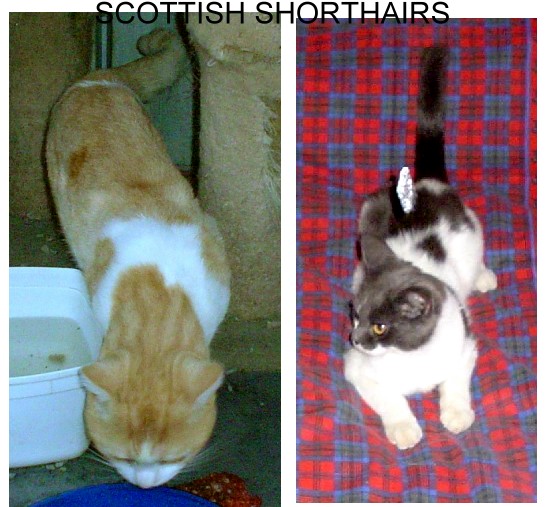
In 2005, breeder Peta Cohen (Kamikai Kattery, Victoria, Australia) came across two Scottish Shorthair (straight-eared Scottish Fold variants) cats with unusual coat patterns. One was a red-cream-and-white which also had two dark red patches on the coat. According to Lesley Morgan, who has handled the cat at a show, this cat is a silver; silver along with white spotting frequently causes cream to present with blobs of red tone - while it can look like an odd tortie, it's just a side effect of red-on-silver. The other was a black-blue-and-white patchwork - again, if silver is present it can cause the dark blobs of colour. These cats both had a mix of dilute and non-dilute colours, indicating chimerism. They came from a Scottish Shorthair/Fold breeder who had also bred a chocolate-lilac-cream female cat, and several more red-cream-and-white patched cats and black-blue-and-white cats which indicates that it is indeed due to the silver gene and not to chimerism. Coincidentally, in 2008, an unrelated male torbie-and-white Scottish Fold was reported.
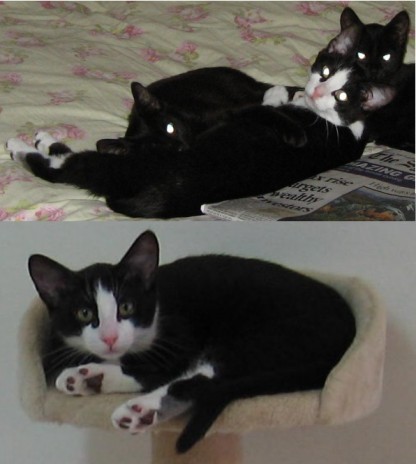
On 23 Feb 2008, Lorna Bowles was catching and neutering some abandoned cats including several kittens. One of the male kittens, Prince, is a black-and-white with small blue (grey) patches on both hind legs. Lorna has provided these photos.
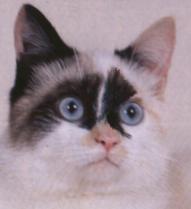
Chimerism is less readily apparent in females, but is a likely explanation of genetically impossible colour combinations. The female tortie-and-white above is a black-cream-white tricolour - an impossible combination according to normal inheritance rules. Black is a non-dilute colour, cream is a dilute colour. A normal tricolour is either black-red-white or blue-cream-white because the dilution gene acts on both colours in the coat. To have a mosaic pattern of both black and cream, she would have to be a chimera of a black (non-dilute) embryo and a cream (dilute) embryo. Since she seemed structurally normal when spayed, both embryos were probably female. This is one of two black-cream-white females (both blue-eyed, but not colourpoints) I have seen.
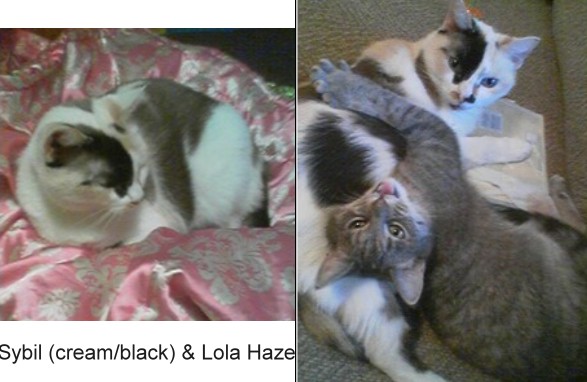
Nicole S's cat Sybil (above) also appears to have both dilute (cream and blue) and non-dilute (black) colouring. The markings on her face, tail, and paws are black while markings on her back and face are cream (with ghost tabby markings). The black occurs beside her nose, behind one ear, around one eye and on the back of one leg . On her body she has dark blue (grey) markings with a black tabby pattern overlaid. Her eyes are blue. She is neither a red/black tortie nor a blue/cream, but has a mix of cream, black and blue (grey). The difference in colours at the points and on the body is not consistent with colourpointing (despite the blue eyes) which suggests Sybil may be a chimera.
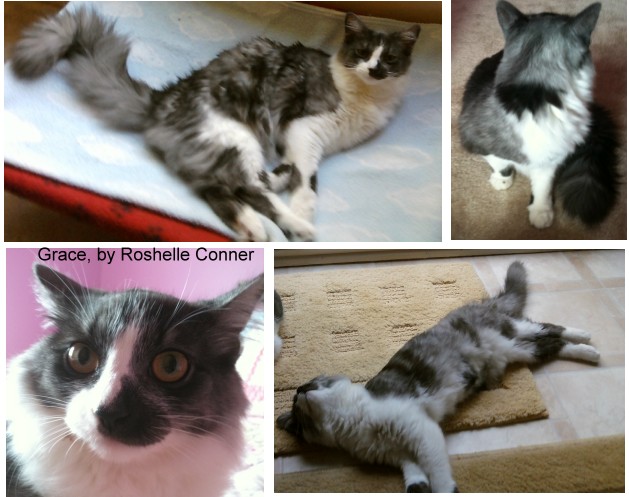
Roshelle Conner's female cat Grace (above), has a coat that is a mix of black, blue (grey) and white patches; the black and blue are not arranged in a tabby pattern. One front paw has a black spot on one side and a blue spot on the other. Roshelle describes it as "when she is sitting, from the side, it almost looks like she has a long gown with a hoop skirt under it, and layers of lace (brindling), on the dress!"
Another possible chimera was Islamorada Lunacy who had a mix of solid black patches, tabby patches (most visible on the left leg, betwee the ears and besid the nose) and white patches plus blue eyes indicative of a high degree of white spotting in one of the embryos involved.
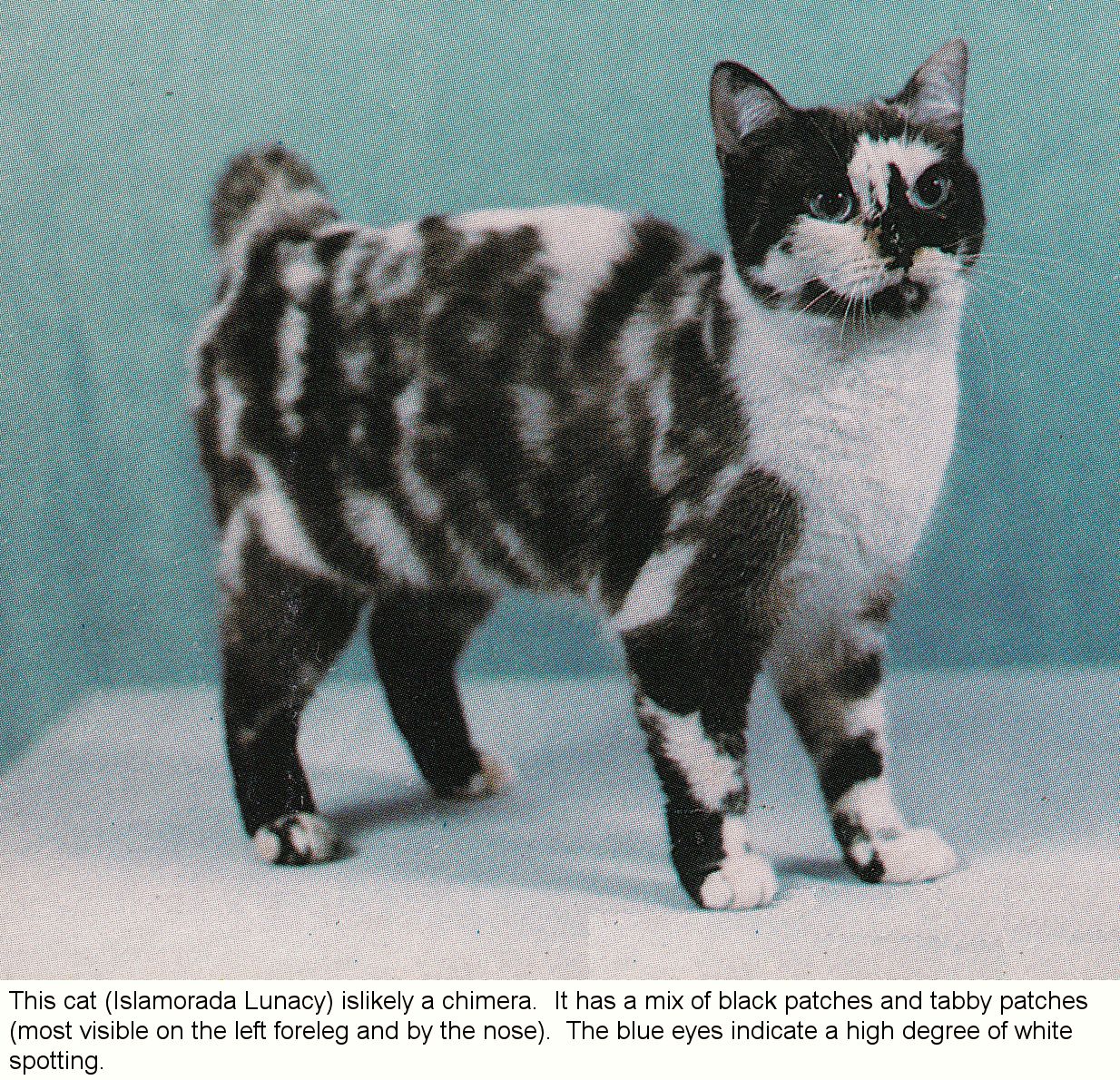
A mosaic that made online headlines in 2012 was "Venus the Chimera Cat". Venus is a tortie cat with a brindled body and a face that is a perfect half-and-half of black and ginger. Intriguingly, her eye on the ginger side is blue, while that on the black side is green. This alone didn't diagnose Venus as a chimera (fused embryos) cat - that requires DNA testing of the black and ginger sides to determine. In such strikingly marked cats, the solid black area can be a result of cell mutation (resulting in an effect like a birthmark). The colour of the fur is linked to eye colour, so a mutation in that area could affect both skin pigment and eye pigment. Blue-eyed ginger cats are unusual, but not unknown and may be related to the white-spotting gene. It would require tissue tests to confirmed that Venus was a chimera ("fraternal twins in a single body"), because such colouration occurs as a striking manifestation of normal tortoiseshell genetics. Other odd-eyed tortie cats have occurred, as have other half-and-half black/ginger faces.
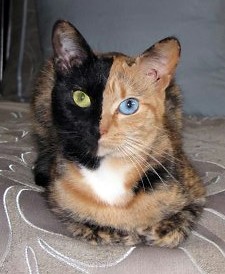
|
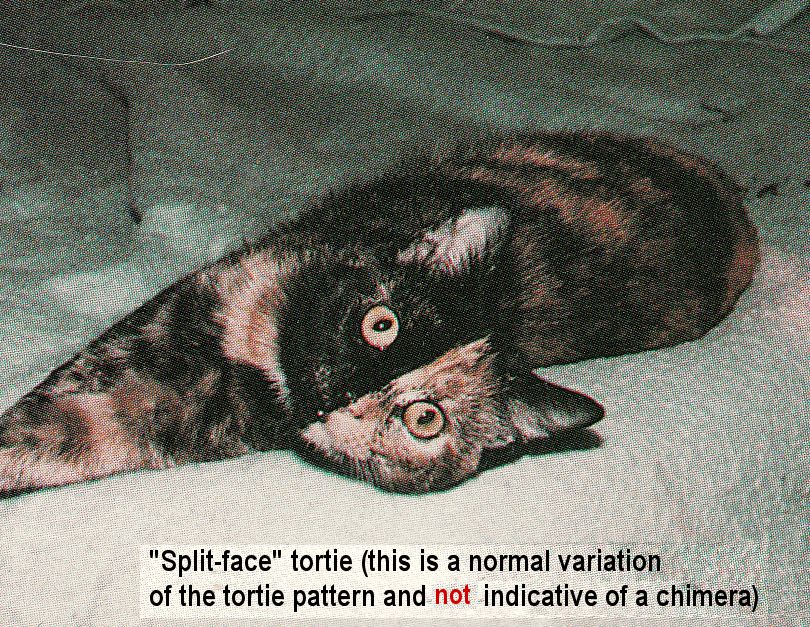
|
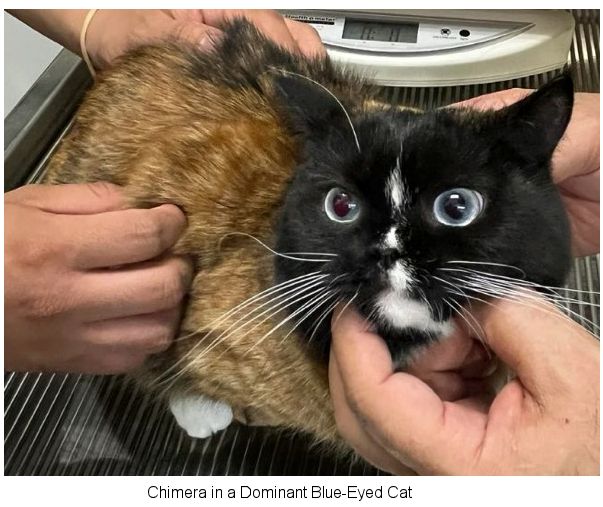
Candice Prowting of Eiserblew Ragdolls (UK) contacted me in November 2013 about a probably chimera Ragdoll male. Panda (his pet name) was born from two Seal Point Mitted parents; both carrying dilution and neither carries chocolate or cinnamon. On his right side, Panda has two blue legs, and on his left side he has seal colour legs. This mix of dilute and none-dilute colours is genetically impossible. Candice assumed his blue side would darken to seal, but this didn t happen. Candice has contacted a couple of geneticists regarding testing to determine the genetic make-up of the blue side and the seal side. It is hoped that he can be test-mated to a blue-point Ragdoll later on to see which of his two colours he passes on.
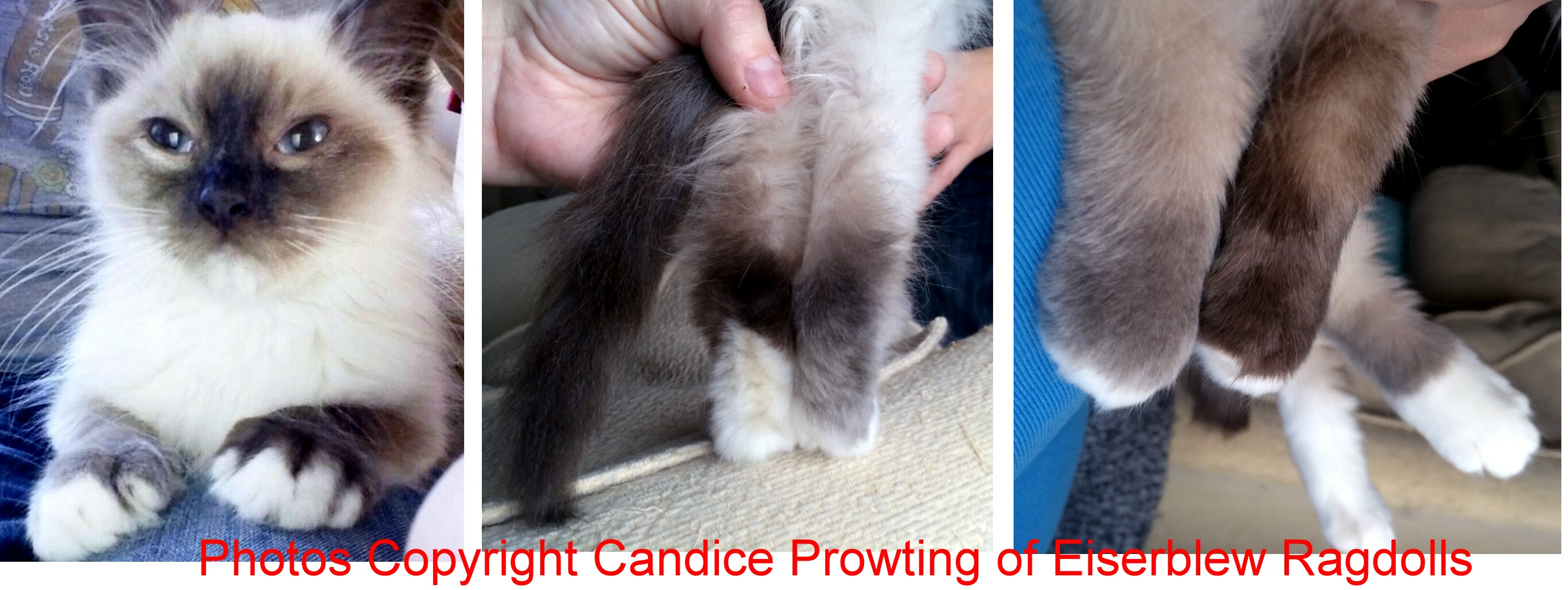
Hi Candice, we now have the repeat of the Dilute test and it is exactly the same as yesterday.....so there is no doubt that something odd is going on in this cat. As I said previously, the most likely reason is a Dd dd chimera since this gives the 25% D, 75% d ratio we are seeing. There is something we could do to investigate this a bit further, but you (and especially Whatami) might not want to try it! It is possible to get DNA from hair roots, so we could look at the Dilute status from Blue and Brown hairs.....these should be dd (100%) and Dd (50:50) if he is a Dd dd chimera. The hairs would need to be pulled out (not cut off) since we would need the roots, which contain the cells that have the DNA. We would need 10-20 hairs from each of the Blue and Brown areas. If you wanted to do this we could do the work free of charge for both our interests! Let me know if this is something you are interested in doing, if it is we can send you some small tubes to put the hairs in....it's best if the root end is put in the tube and rest of the hair cut off, it's only the roots we need! - Dr Chris Helps, Senior Research Fellow, Head of Molecular Diagnostic Unit, University of Bristol, Langford Veterinary Services, Bristol
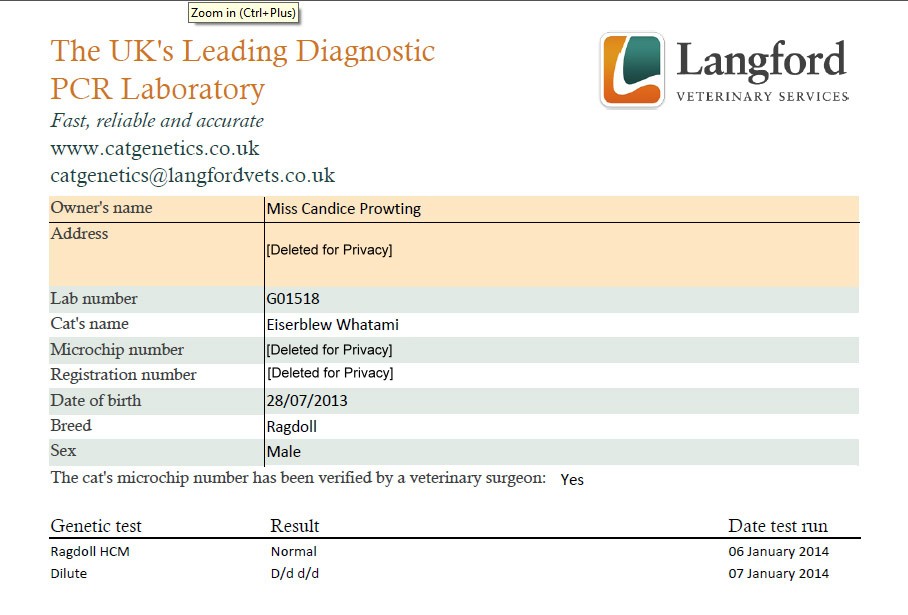
Tests on the hair roots from the left and right side of Whatami showed that one side was genetically different to the other. Unfortunately Candice never bred a litter from him. He wasn't a happy entire boy, and though he mated with a couple of girls no kittens resulted. For Whatami's happiness he was neutered and now lives as a spoilt pet.
Then, in September 2016, Helen Fitton also reported a Ragdoll, Snugglepuss Dreams, that was an impossible mix of seal and blue colours and also contacted Langford, where Whatami's hair had been tested. Dreams' mother is blue mitted carrying chocolate, and the father is seal carrying chocolate and dilute. He has a normal blue-pinted sibling, shown in comparison photos.
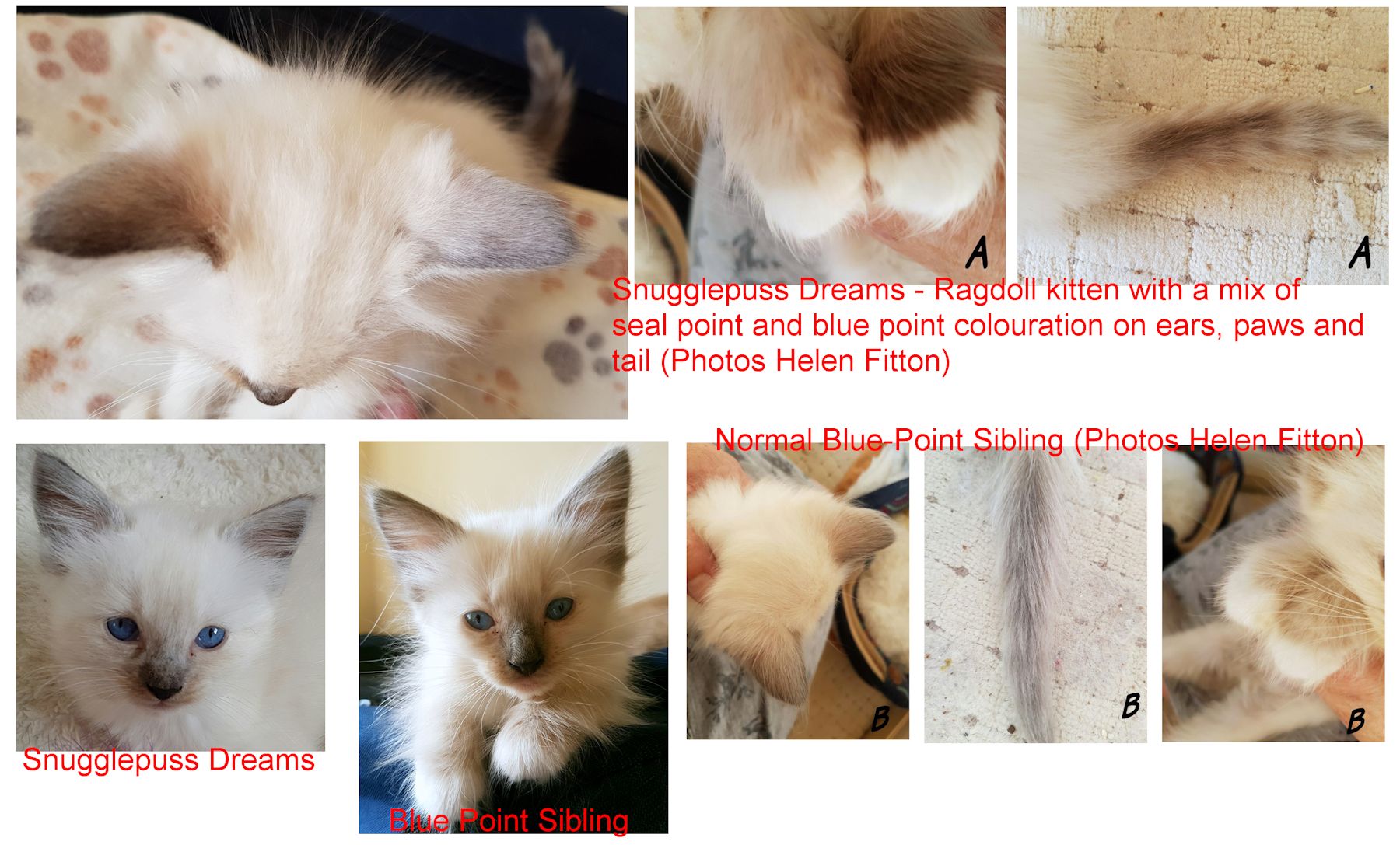
Dear Helen, I can see why you are questioning whether Snugglepuss Dreams is a chimera - there is certainly a visible difference in colouration which is not symmetrical. Given his parentage, it is also possible to see that one side does appear more blue than the other, especially on the ears.We have gone back and had a look at the sequencing that is available to us to see if there is any obvious difference which might flag him as a chimera. His results are unremarkable, with nothing which stands out as unusual. This doesn't completely rule out a chimera, as we are only looking at cells from one anatomic site (the mouth) and it's possible that this is not a 'mixed' area of tissue. If you would like to, we could try and have a look at hair from the differently pigmented areas (we would need the whole hair rather than clippings) to see if we can see an obvious difference. [. . .] I would be very interested to see how Snugglepuss Dreams colouration might be in a couple of years - if he is still markedly different/ asymmetrical at 3 years, it would certainly add weight to the possible chimerism. - Kathleen Tennant, Clinical Lead, Diagnostic Laboratories.
Hi Helen, I have looked at the sequencing results for Snugglepuss Dreams. As you know the results say that he is Seal carrying chocolate and dilute, which would fit with his parents' genetics. However, the pictures of the ears say that he could be blue! I suspect that he could be a Chimera resulting from the fusion of BbDd and BBdd or Bbdd embryos (all 3 genotypes are possible from the parents' genetics), resulting in seal and blue areas. The mouth swab has taken cells from only one area, which is BbDd. We have looked at one other Chimera with similar presentation, in that case we looked at the dilute genotype of hair taken from light and dark areas to see if there was a difference. Whilst not 100% conclusive, probably due to a mixture of cell types, the hairs from the lighter areas showed a higher percentage of the dilute (d) genotype compared to the darker areas, which would be expected in a Chimera. I spoke to Leslie Lyons about the previous Chimera and she said they were more common than people might expect, although I'm not aware of a simple test to detect them! -
Dr Chris Helps BSc PhDNEXT PAGE: Klinefelter Syndrome (XXY Males)
REFERENCES:
- O Brien SJ, Wienberg J, Lyon LA: Comparative genomics: lessons from cats, Trends Genet 13:393, 1997.
FOOTNOTES: CHIMERAS IN OTHER SPECIES
In an experiment done with white mouse embryos, cancerous mouse cells were injected into the embryo. During foetal growth the cancer was somehow tamed and the effect of the cancerous cells was to produce black patches in the otherwise white mice (uninheritable since they were cell mutations, not inherited through genetics). Rat/mice chimeras have also been produced in the laboratory.
Freemartins
Chimeric cattle are not at all rare. When a cow has non-identical twins, the circulatory systems of the two embryos almost always joins together. Blood stem cells from one embryo end up in the other embryo. Both animals end up as chimeras (microchimeras). Where one is female and the other is male, the female embryo is exposed to hormones from the male. This causes the female embryo to be masculinised. These are called freemartins. The look female and have infantile external genitalia with underdeveloped internal sex organs, but are infertile. Freemartins occur in other species, but less often. It is a a peculiarity of cattle that the blood supplies of non-identical twin embryos join together.
Human Chimeras
Human chimeras also occur. A boy born in 1994 (and reported in 1998) turned out to be genetically two people. Two fertilised eggs had fused into a single embryo. One egg was XX (female) and the other was XY (male), making some parts of his body genetically female while other parts were genetically male. He was outwardly male, but had a partial womb, fallopian tube and ovarian tissue. Others are less easy to detect, such as a woman who had some XY (male) blood cells. This can happen where non-identical twins share a blood supply in the womb and blood stem cells can migrate from one to the other. Another human chimera apparently occurred when an unfertilised egg divided into two. One of the cells was fertilised, the other wasn't. The unfertilised cell contained only the mother's chromosomes, which it duplicated. The fertilisation of the other cell meant the embryo could develop normally and a single XX/XY embryo was formed. Some of the boy's tissues contain only the maternal chromosomes while other tissues contain maternal and paternal chromosomes. A similar scenario occurs when a fertilized egg fuses with an unfertilized egg. In both cases, some tissues contain only maternal DNA and the cause was once believed to be parthenogenesis (the tissues tested were those derived from the unfertilized egg/cell).
In 2003, DNA tests (for kidney transplants) showed that a Boston, USA woman known as "Jane" was not the biological parent of two of her three naturally conceived sons. Her sons underwent blood tests to see if they were compatible kidney donors, but the results showed that two of them did not have any of Jane's DNA, although their father was Jane's husband and they did have his DNA. Initially, doctors thought Jane had undergone fertility treatment using donated eggs or her sister as a surrogate mother. However, Jane's ovaries were found to contained two different sets of genes. One of her sons came from one set of cells, while the other two were derived from the other set of cells. Jane is a tetragametic chimera , one of only 30 reported cases, and is made up of 2 genetically different populations of cells. This occurs when non-identical twin embryos, both female in Jane's case, fuse into a single embryo in her mother's womb. Jane's body contains 2 distinct types of DNA: "her own" cells and "her twin's" cells. Cells from one twin dominate in her blood, but her thyroid gland, mouth and hair carry the other twin's DNA, while cells of both types coexist amicably in her ovaries. Jane's case was reported in The New England Journal of Medicine (Vol 346).
Nature reported a similar case in 1979, when genetic tests suggested that a woman could not be the mother of any of her four children. Again, there were no previous suspicions that the woman was a chimera. In 1978 or 1979 a British tabloid newspaper carried a front page story of a woman who "carried her dead twin in her bloodstream". Although sensationalised, this was another instance of chimerism. The report carried several sensational claims including feeling the lost twin moving within her and blaming it for mood swings! In a case where chimerism is not yet confirmed, doubts were cast on a child's maternity in court during 2003 when a woman sued her partner for child support. Tissue-typing tests have shown that the partner is the father of the child, but that the woman is not the mother. Her case may prove similar to that of Jane.
The incidence of human tetragametic chimerism may be on the increase due to modern fertility treatments that cause women to release multiple eggs or that implant multiple embryos in the hope that some will grow. In 1998, the University of Edinburgh, UK reported a chimeric IVF baby resulting from the fusion of a male and a female embryo (The New England Journal of Medicine, Vol 338). Though outwardly male, the left hand side of his internal reproductive system had developed as female (presumably the child born in 1994 and noted earlier). Although most of the cases cited above are females, it is possible for a man to be a chimera and for his blood and his testes to contain different DNA, confounding the results of paternity tests on his offspring.
Around 30 similar instances of human chimerism have been reported. Some are identified because they have sought fertility treatment or they required DNA testing or tissue matching. It is not known how common tetragametic chimerism is in the population since there are often no outward signs, especially where same sex embryos have fused (a few might have visible pigmentation mosaicism). One girl was discovered to be a chimera because she had one brown eye and one hazel eye. Others are detected when doctors investigate reproductive problems. A few might demand paternity tests, for example where a child has "impossible" characteristics such as a brown-eyed child born to blue-eyed parents. Many, if not most, chimeras will never discover their unusual origins and will go through life unaware of their condition.
There is also increasing evidence that most people are microchimeras i.e. contain cells from their mothers and older siblings. During pregnancy, the blood of the mother and foetus are kept separate, but the placenta is an imperfect barrier and some cells slip through. Children pick up some cells from their mother and she picks up some foetal cells. 80-90% of women carry their children's cells or DNA in their blood during pregnancy and up to 50% carry them for decades after giving birth. Some of those cells may slip from the mother's bloodstream into the body of the next child. Some cells may even pass from her children into her grandchildren. For some reason, our immune systems tolerate these cells in the blood and it may be an essential part of preventing rejection of the foetus. Some of those maternal cells may become incorporated into the body tissues of the foetus (where they may be associated with autoimmune disease although no firm cause-and-effect has been established).